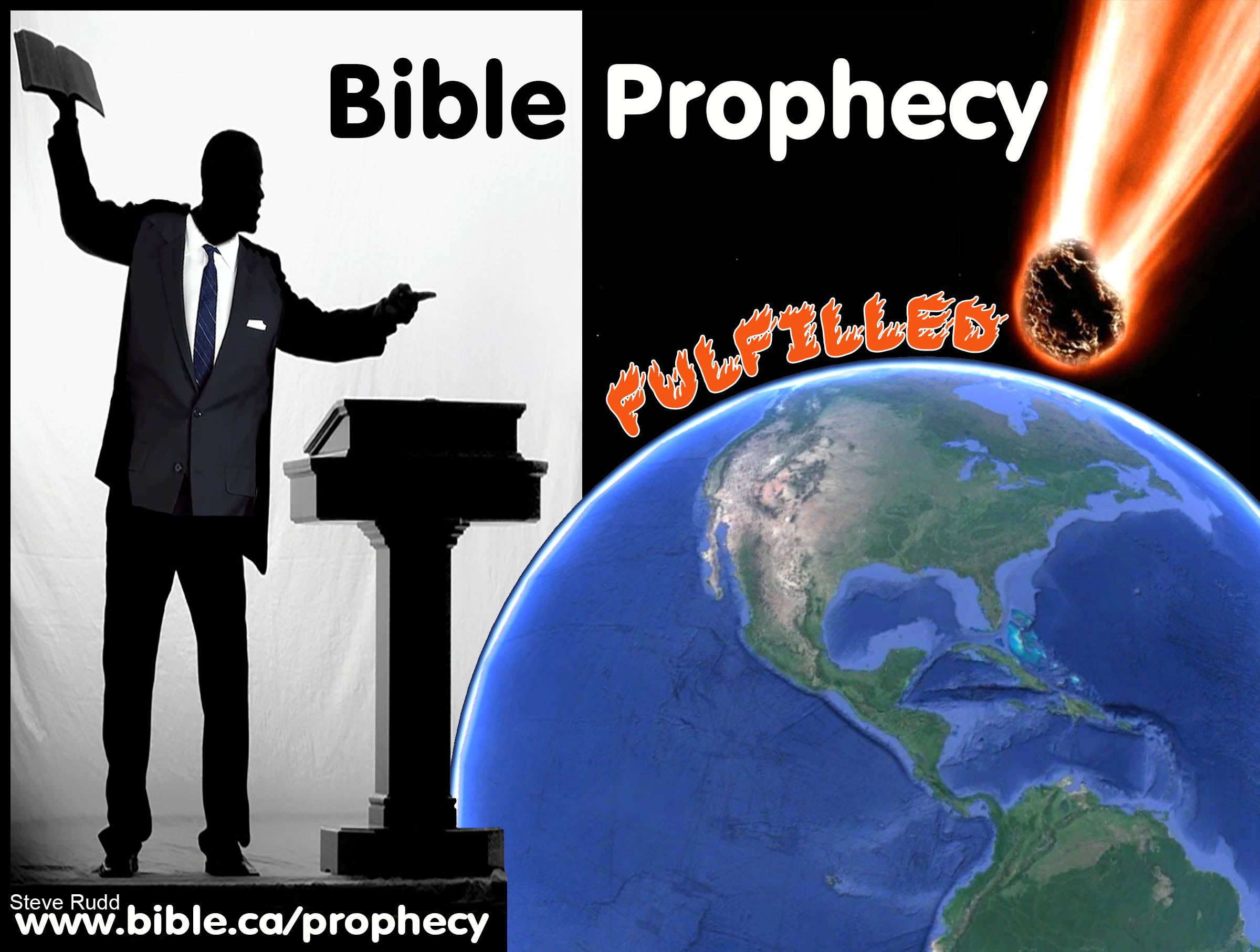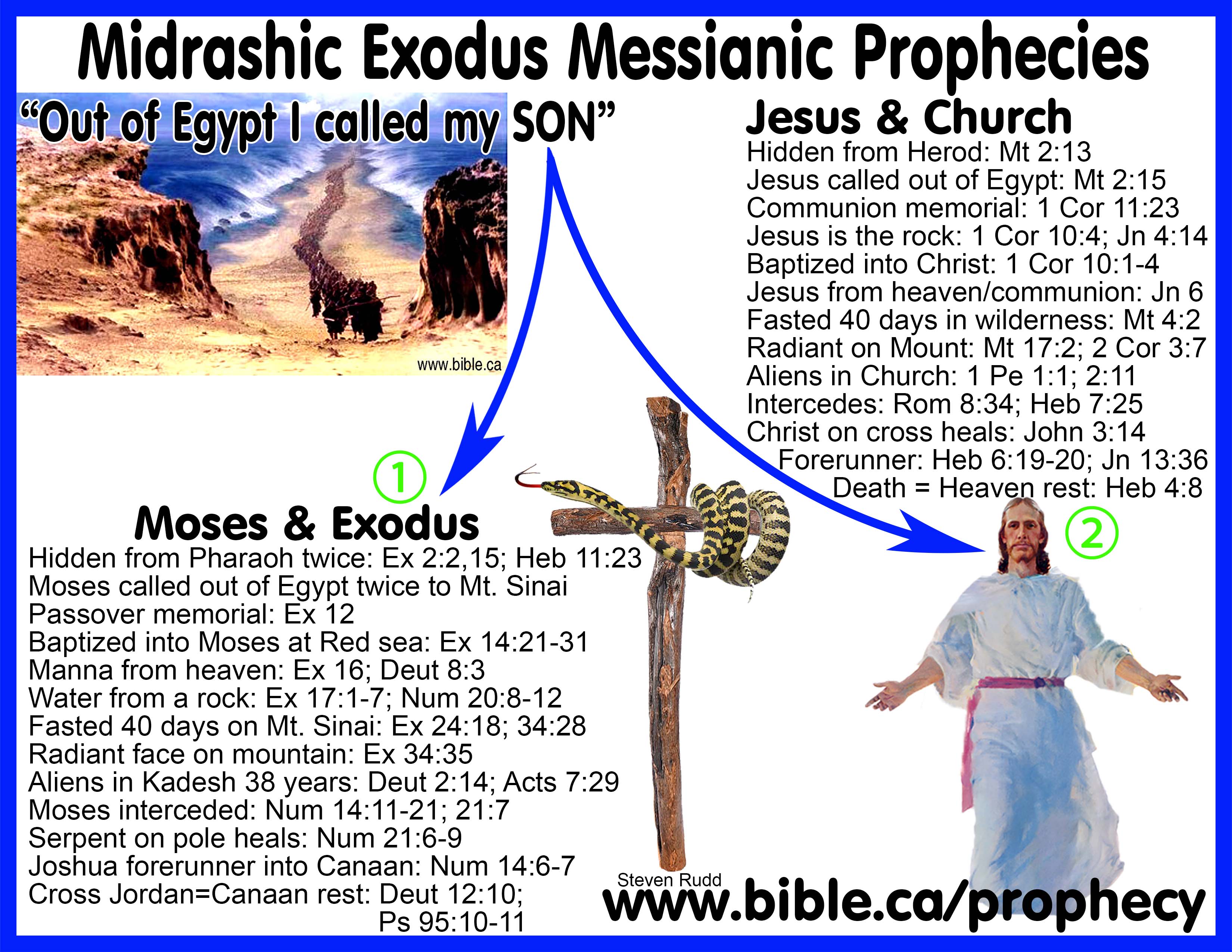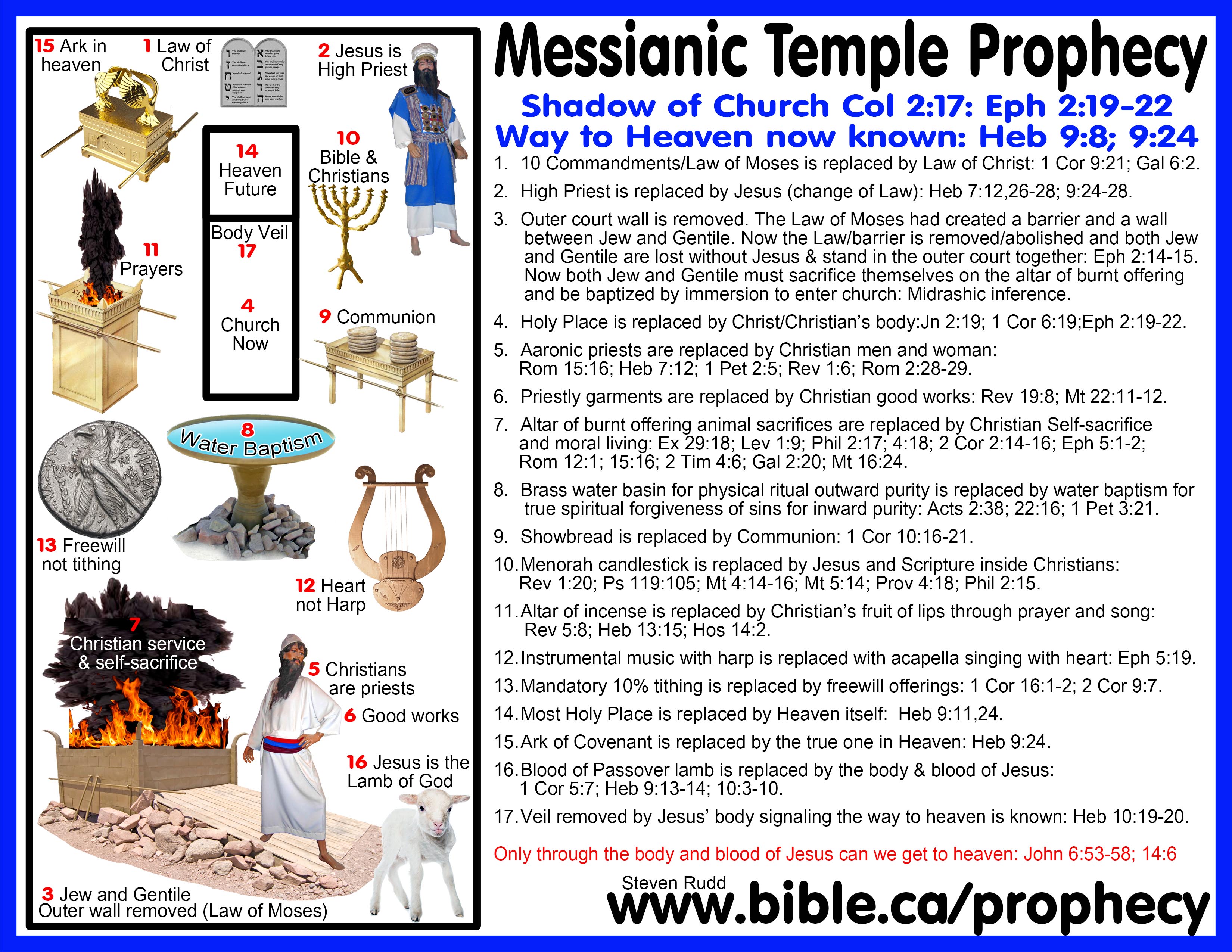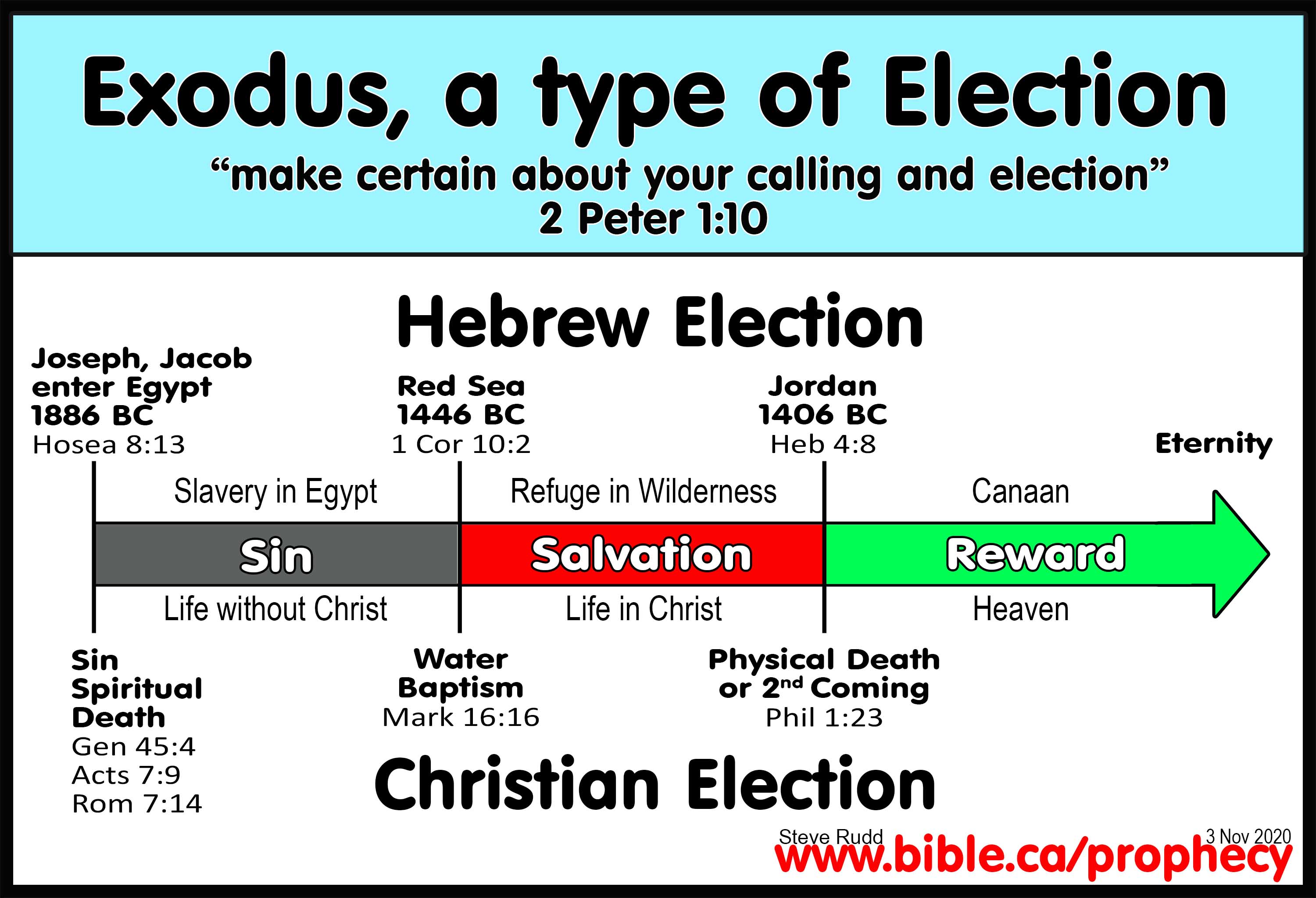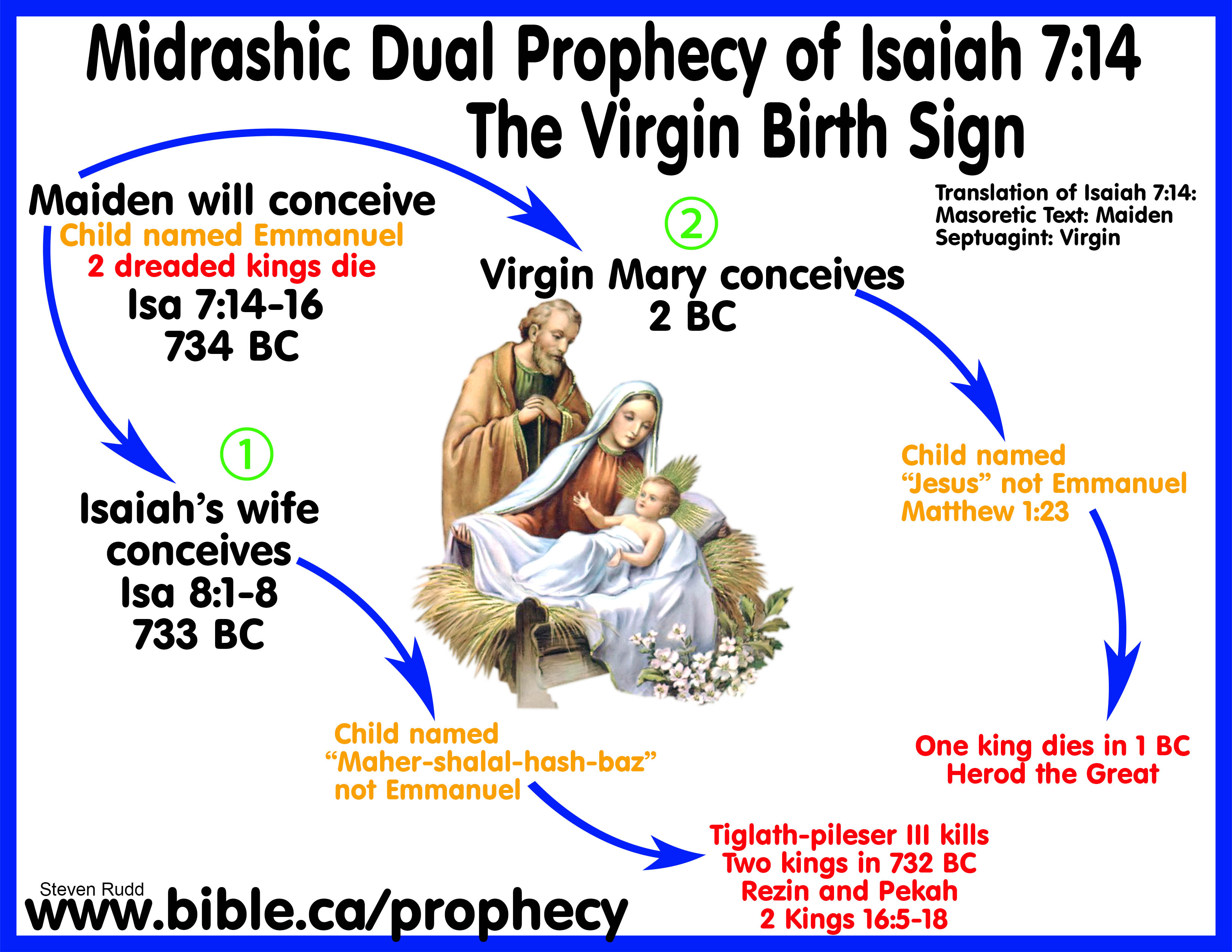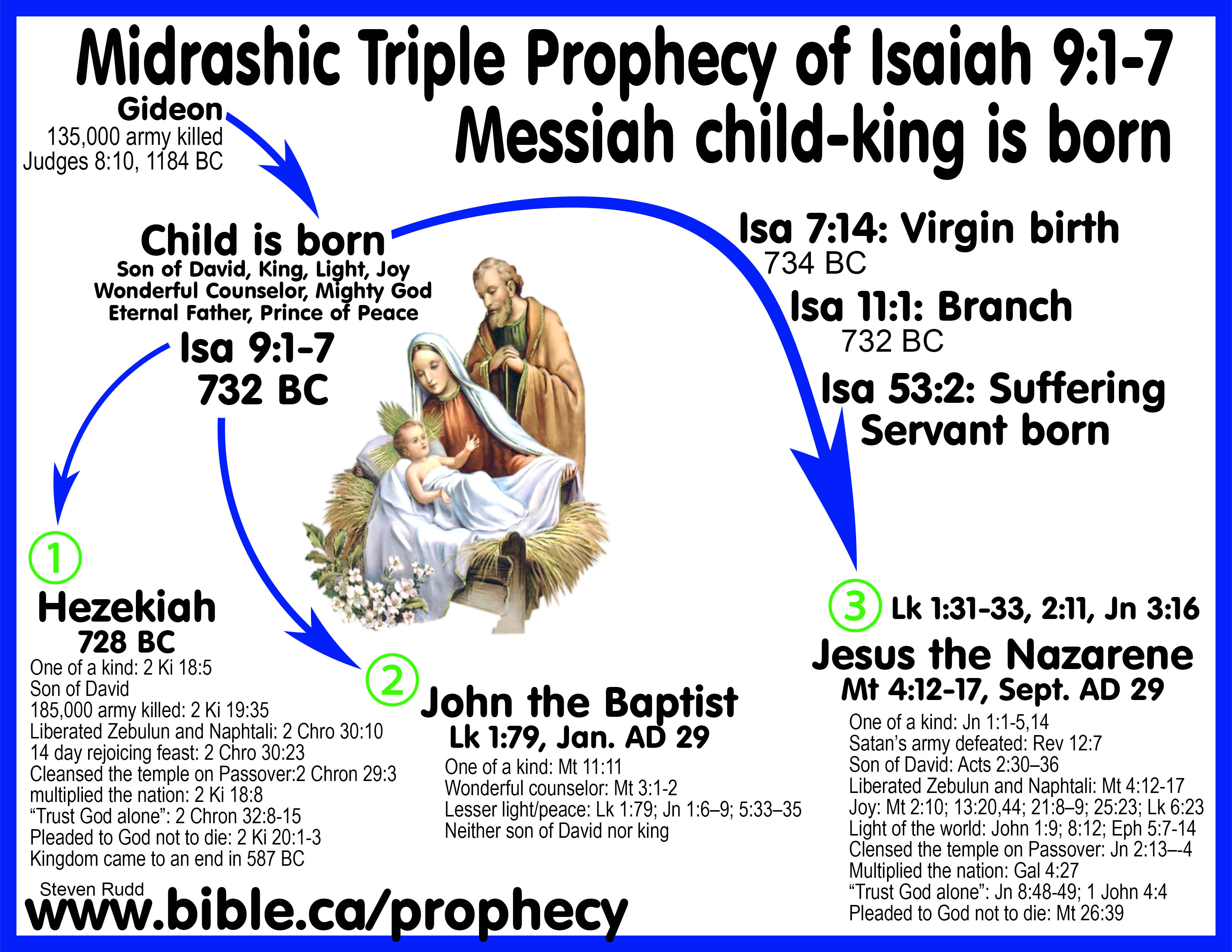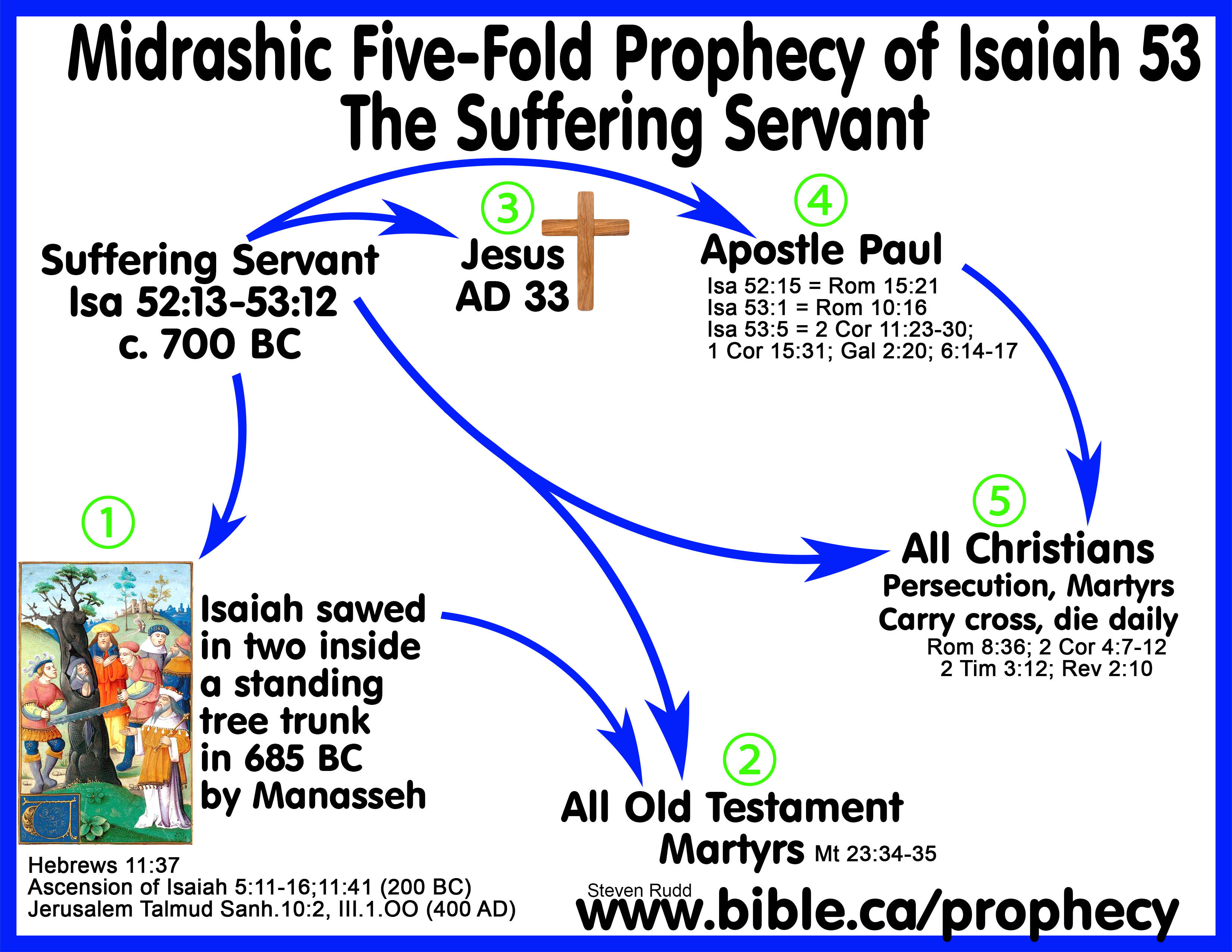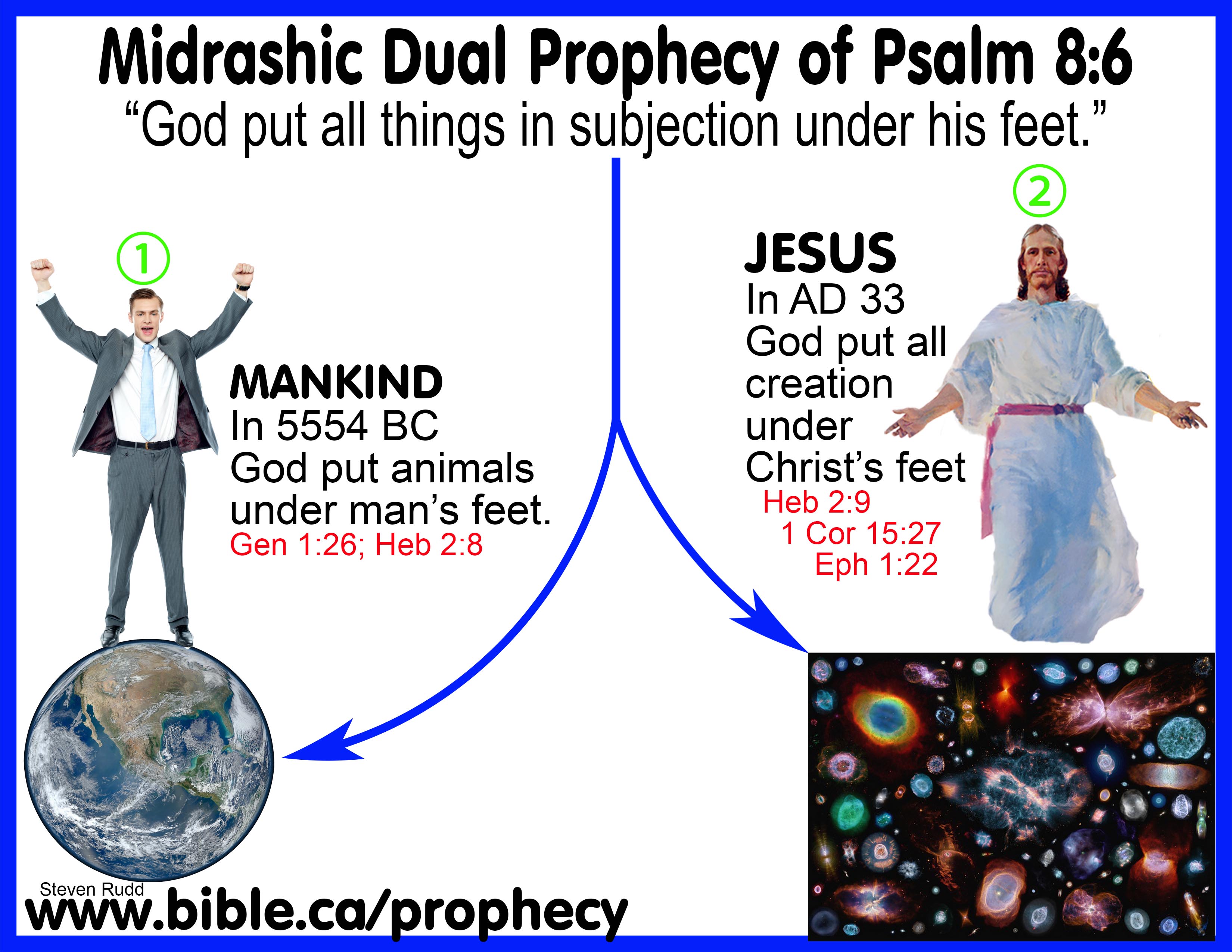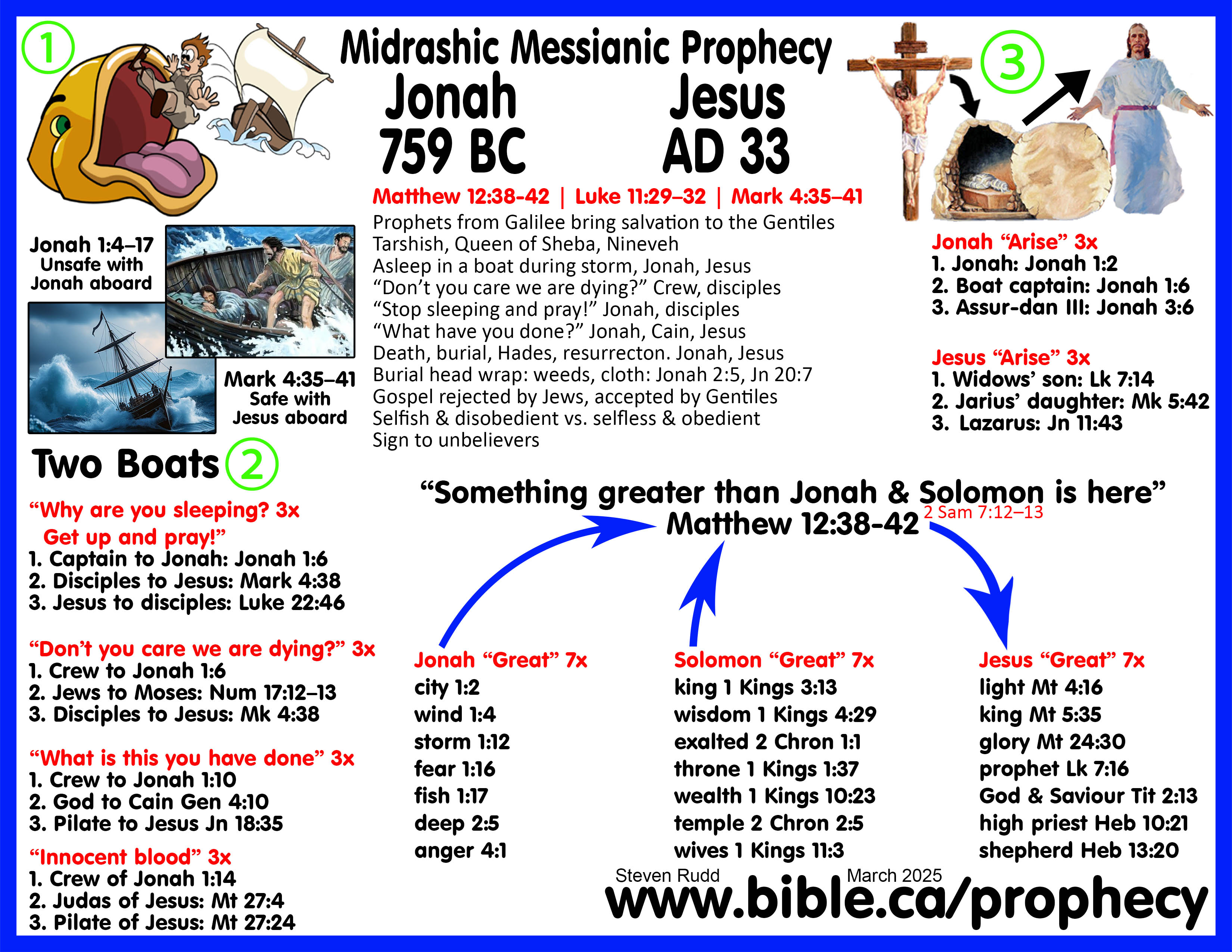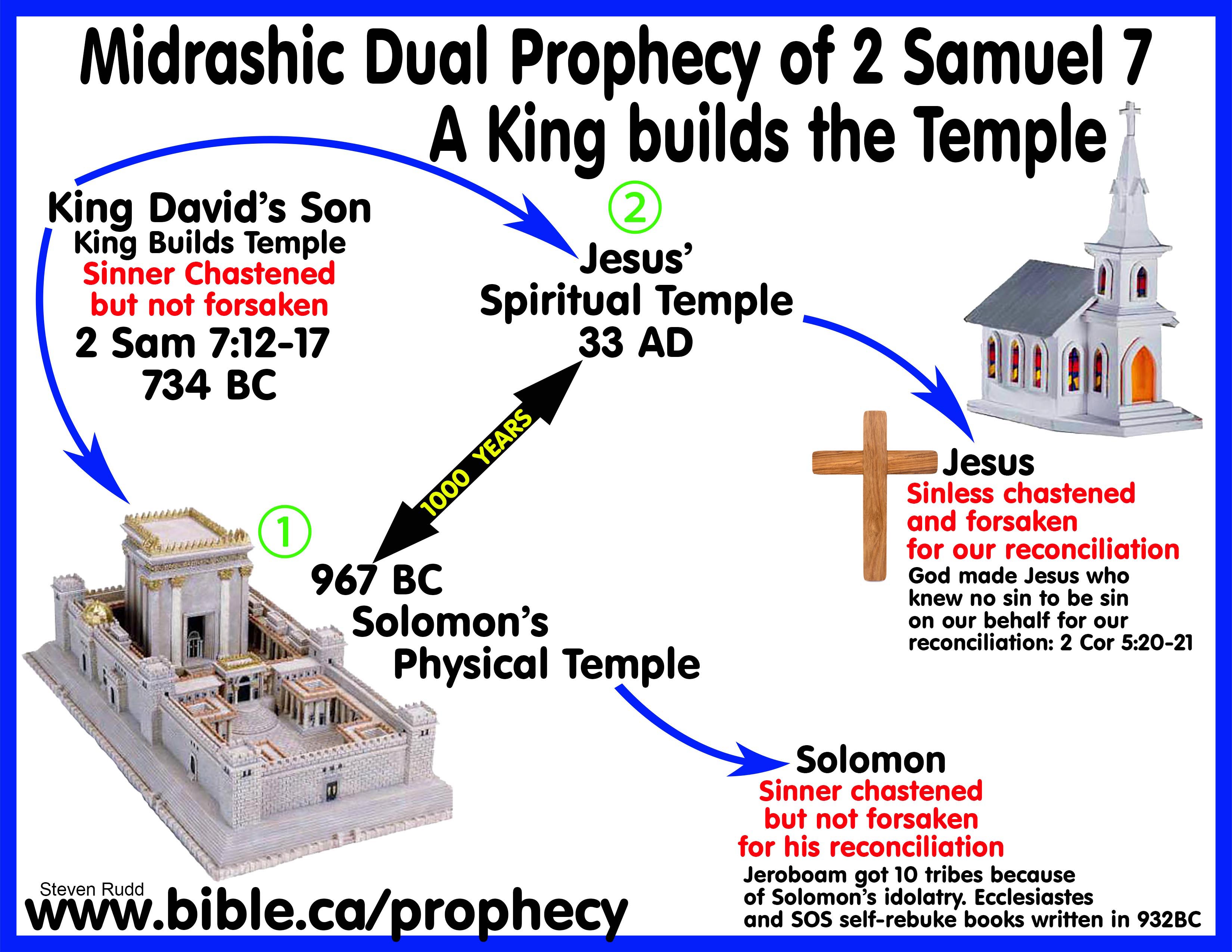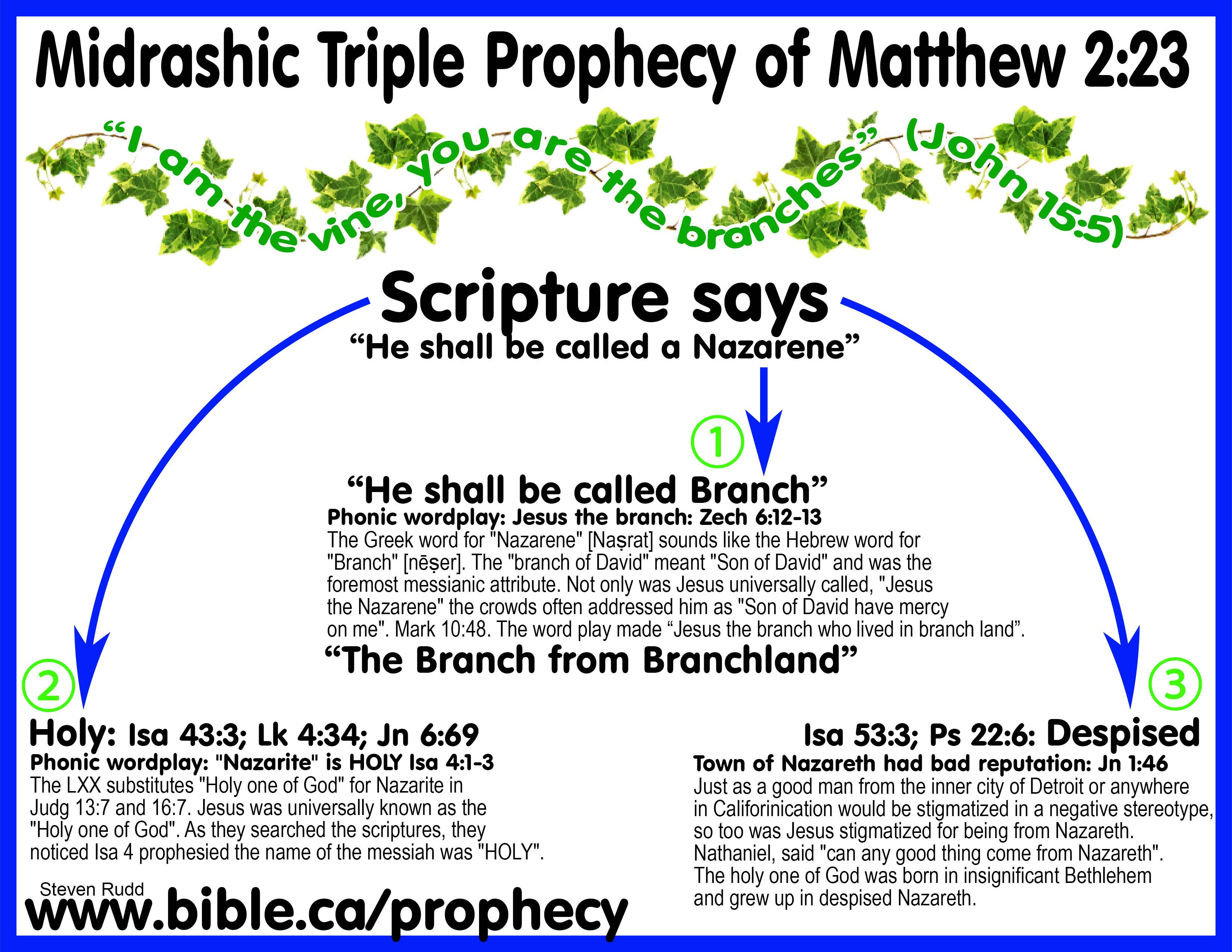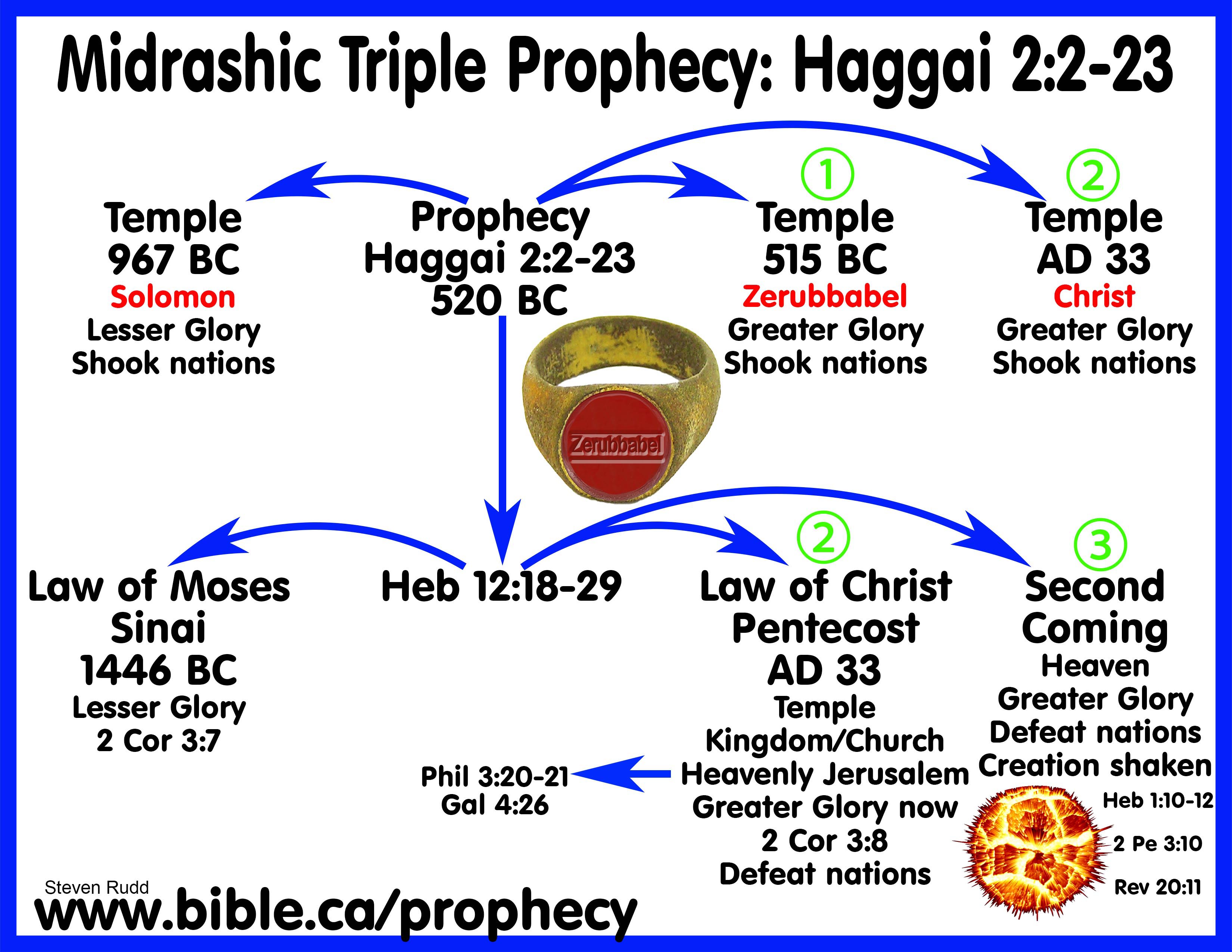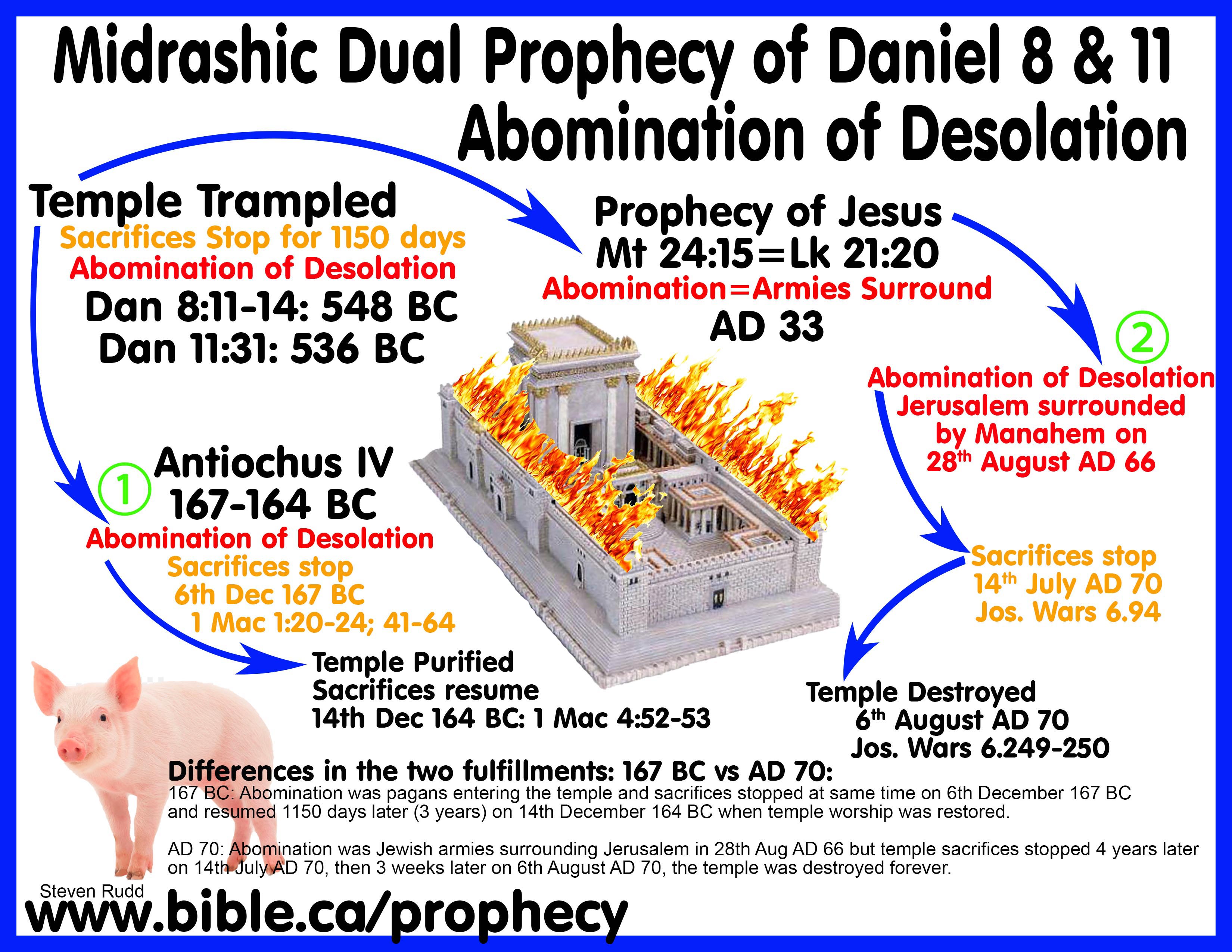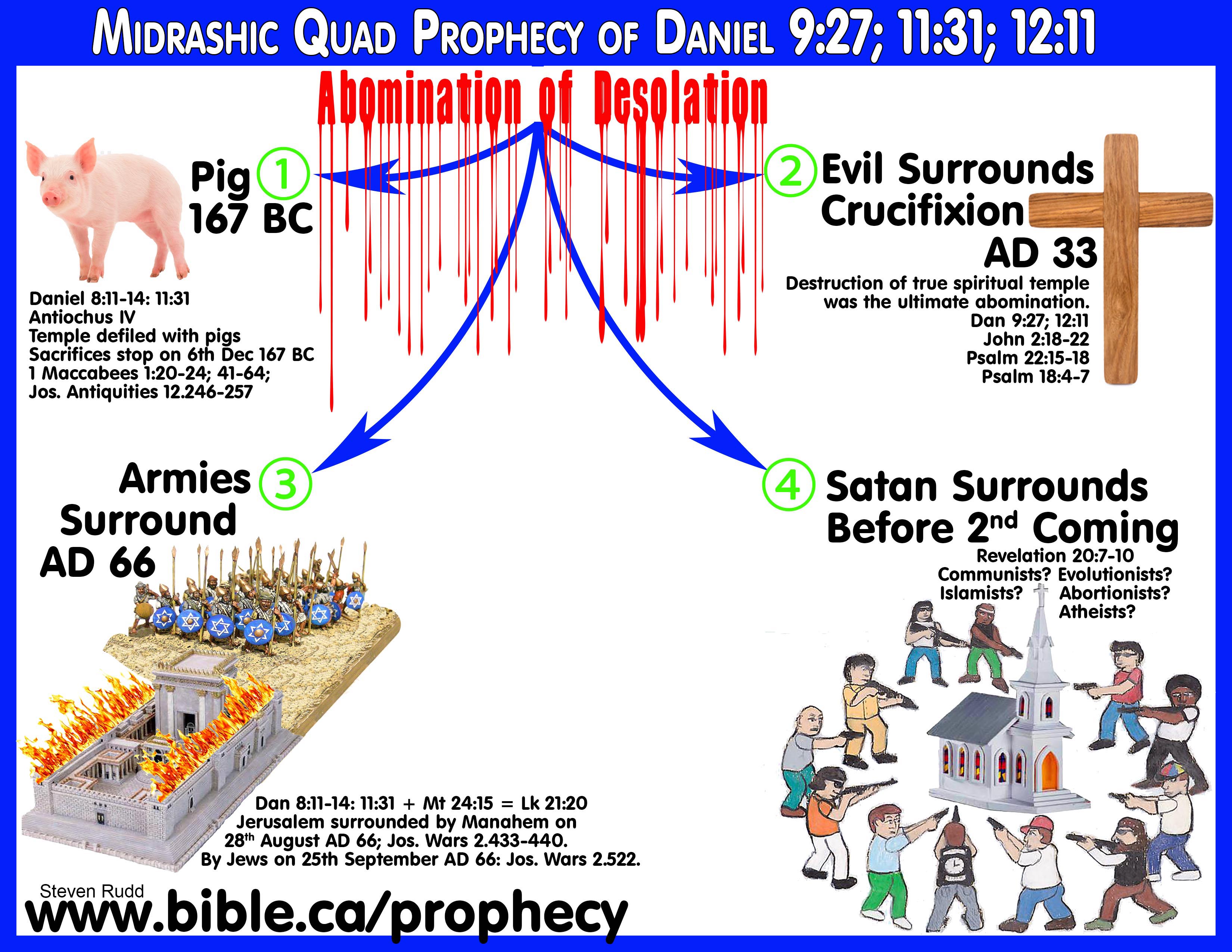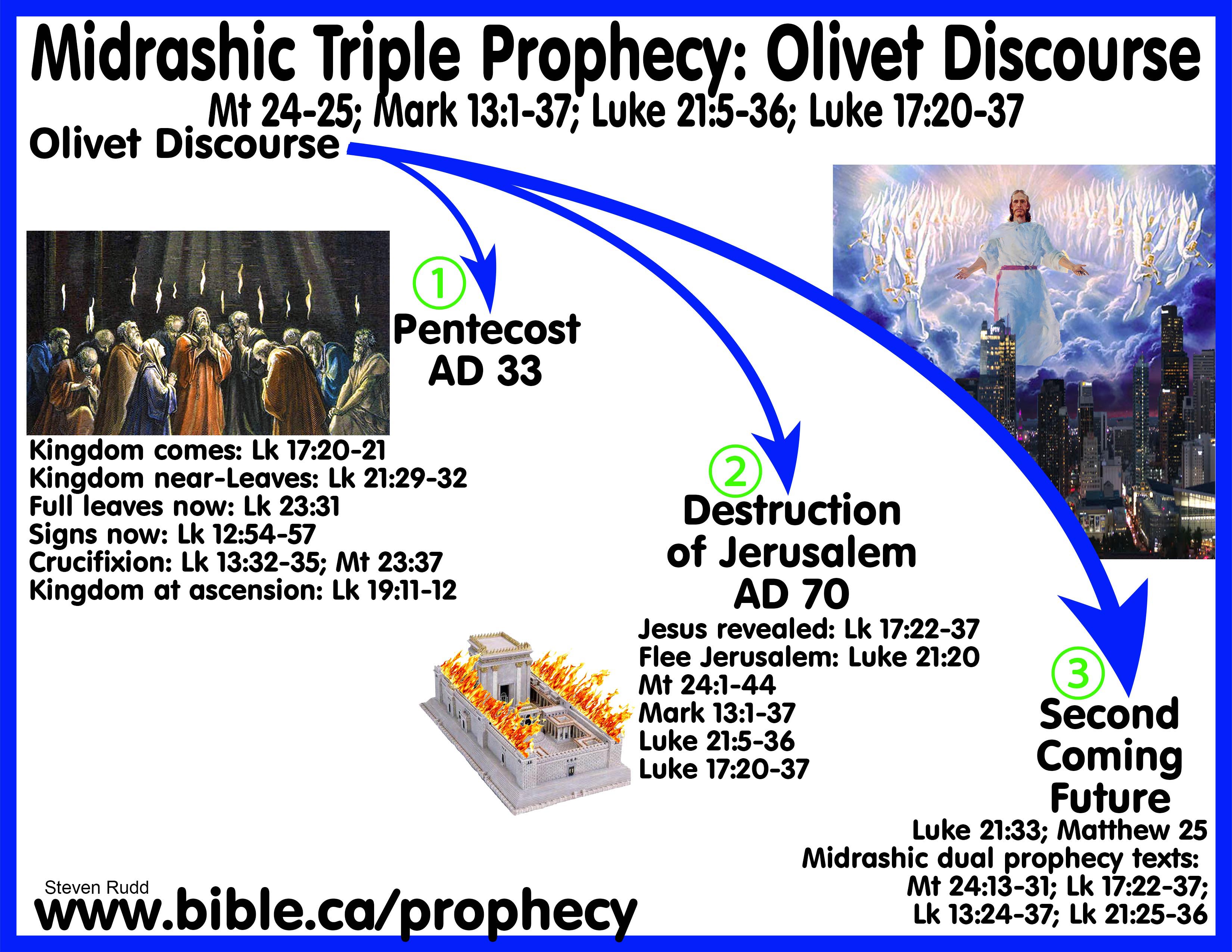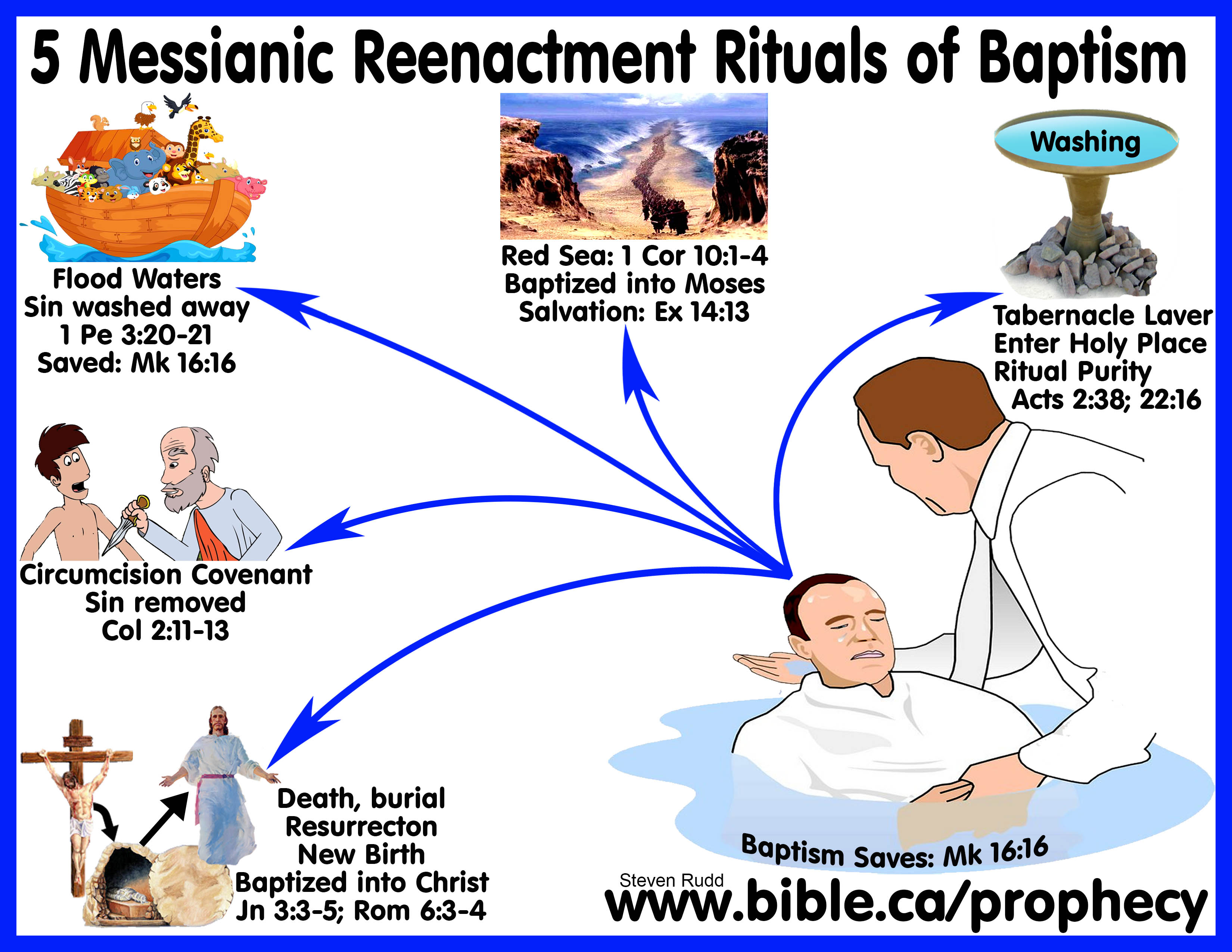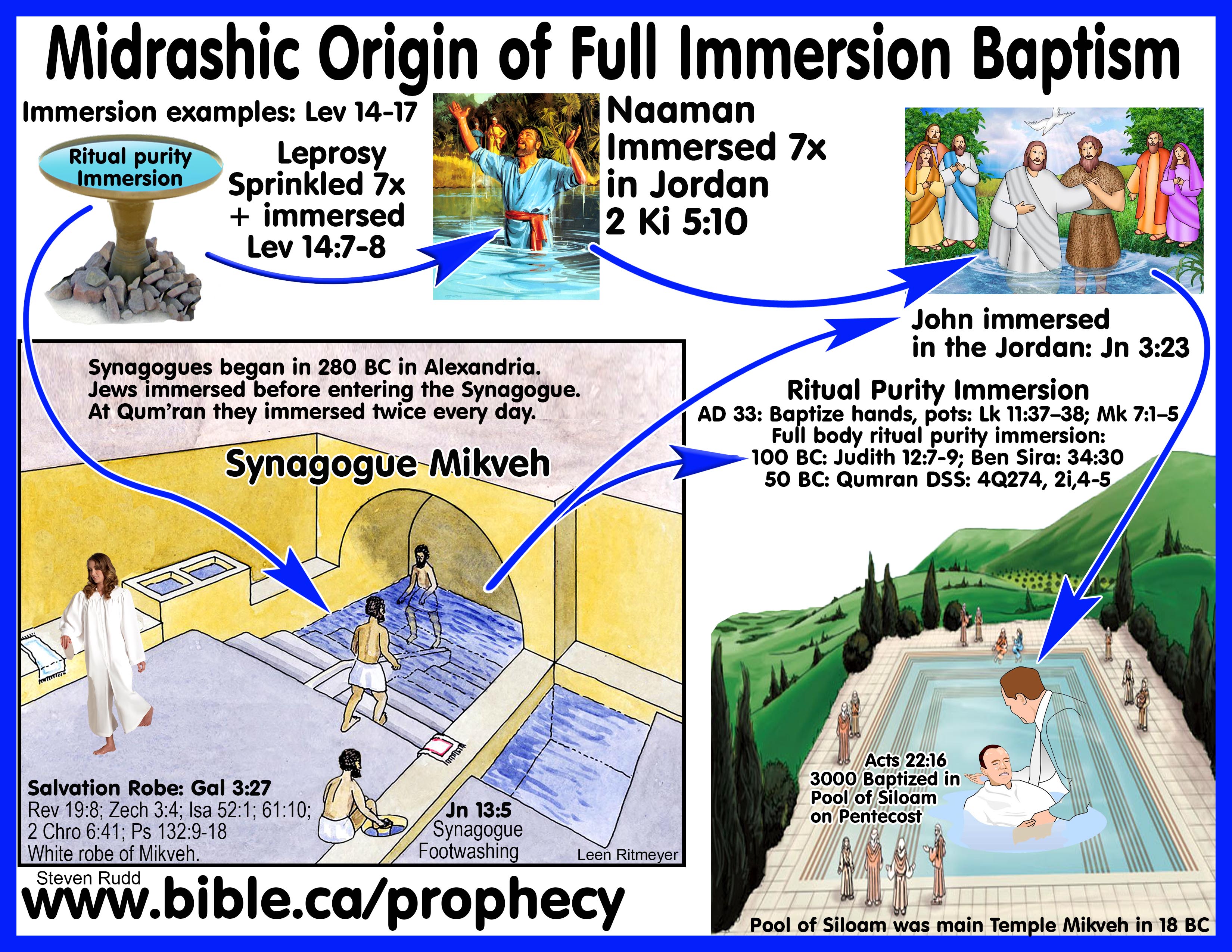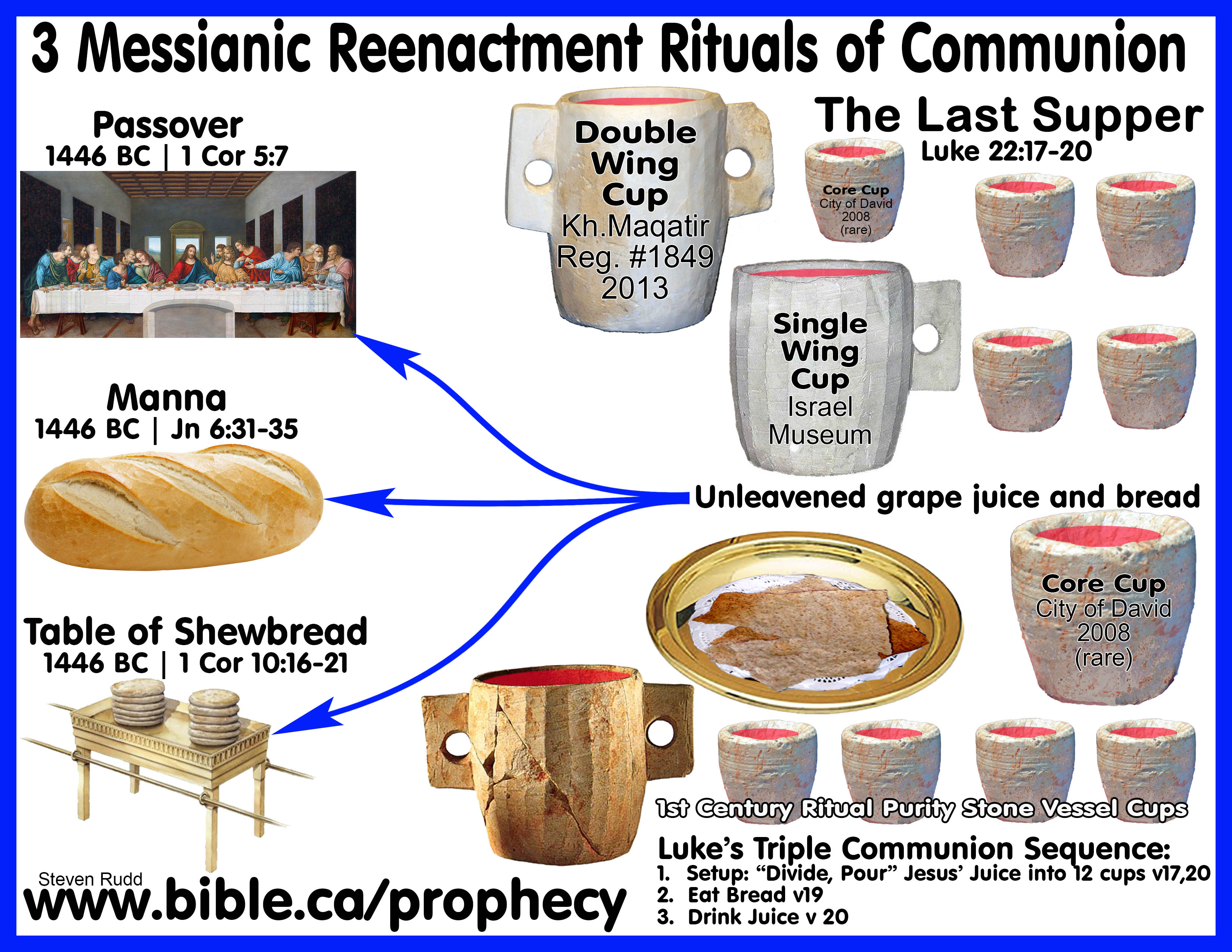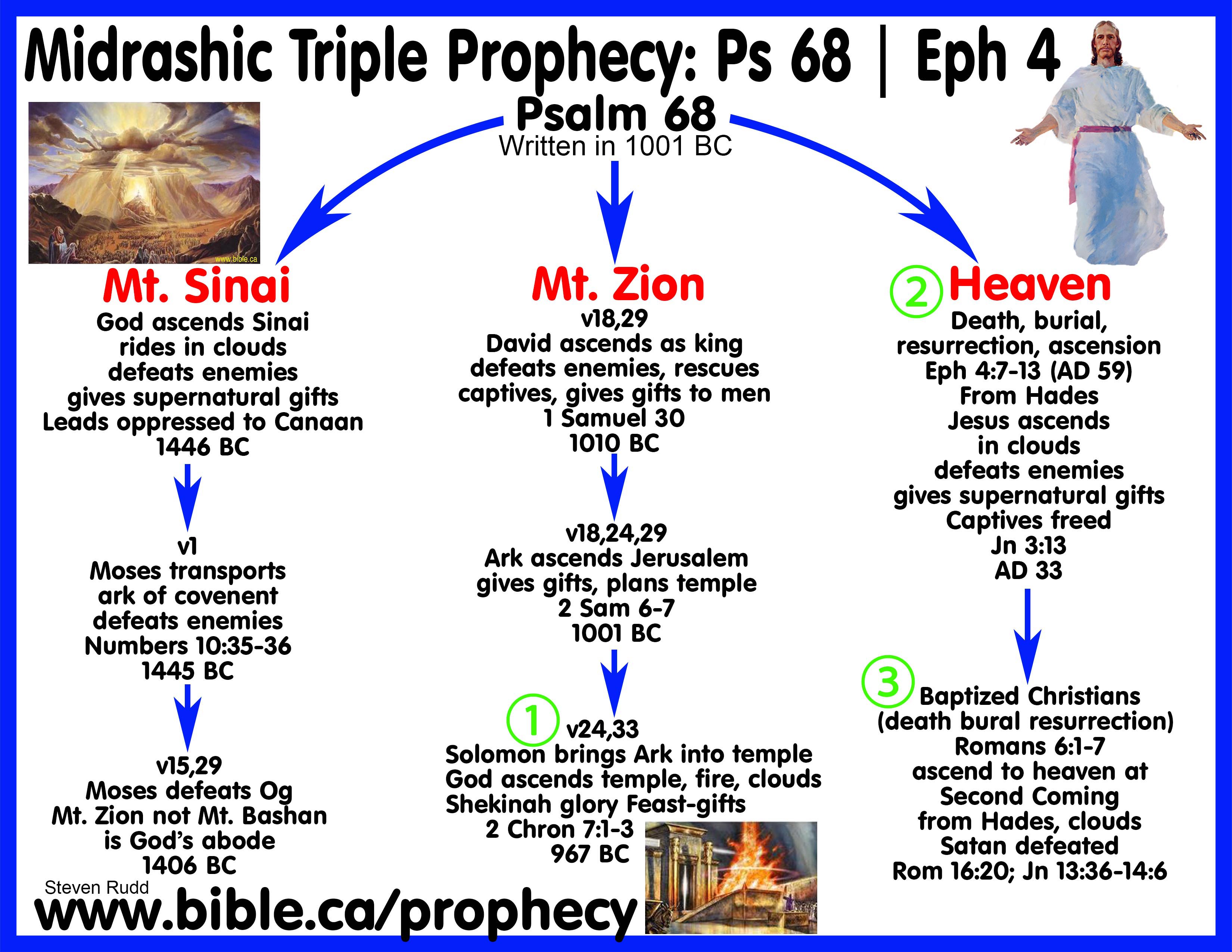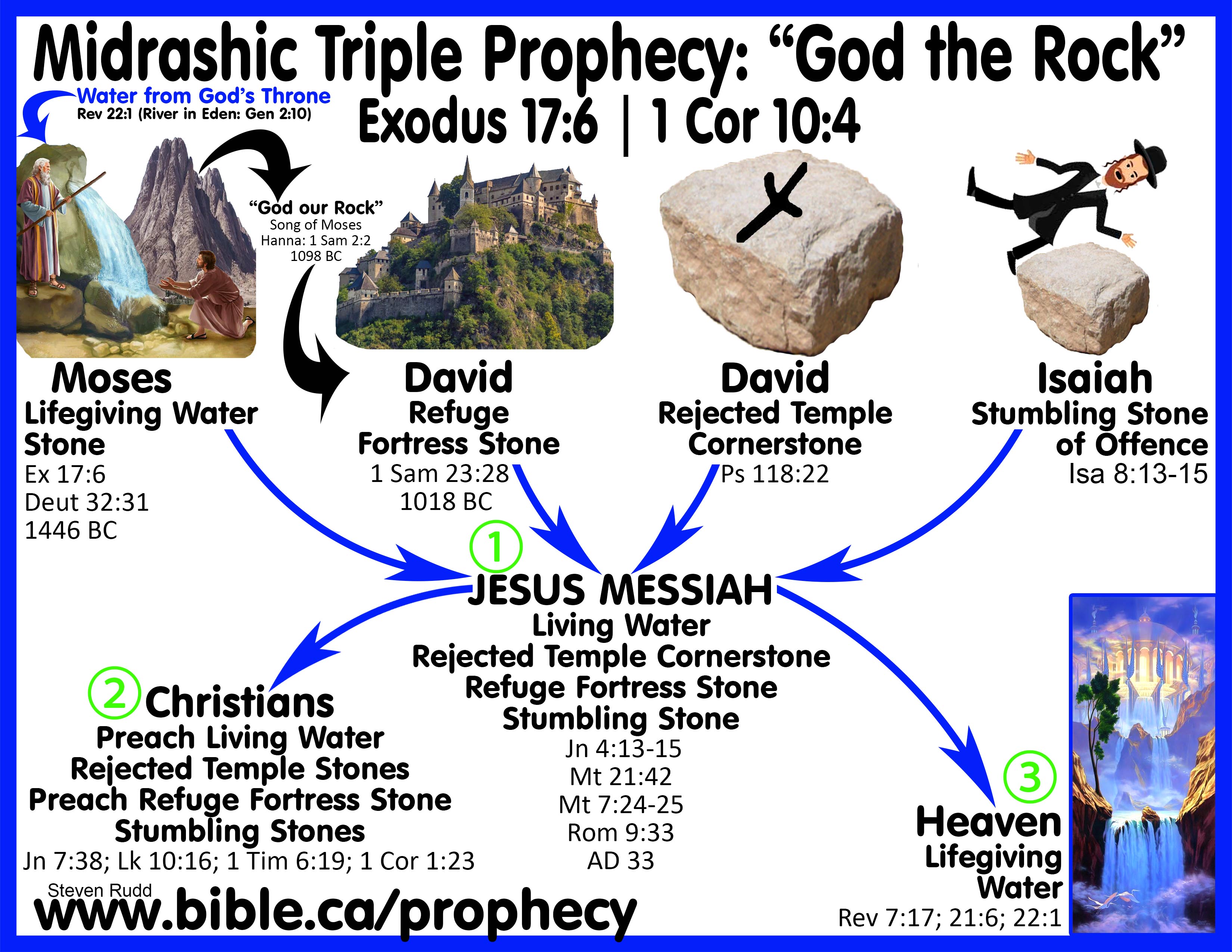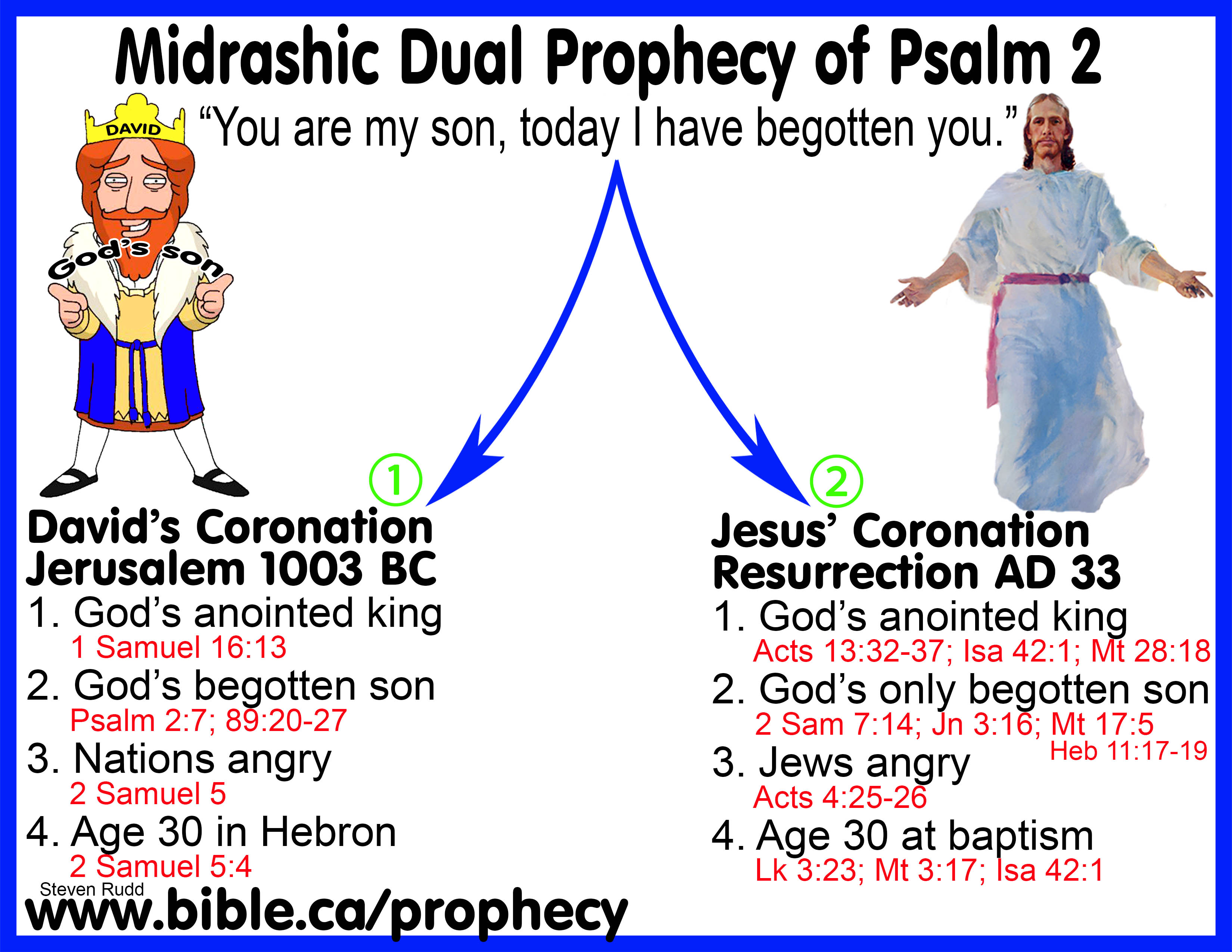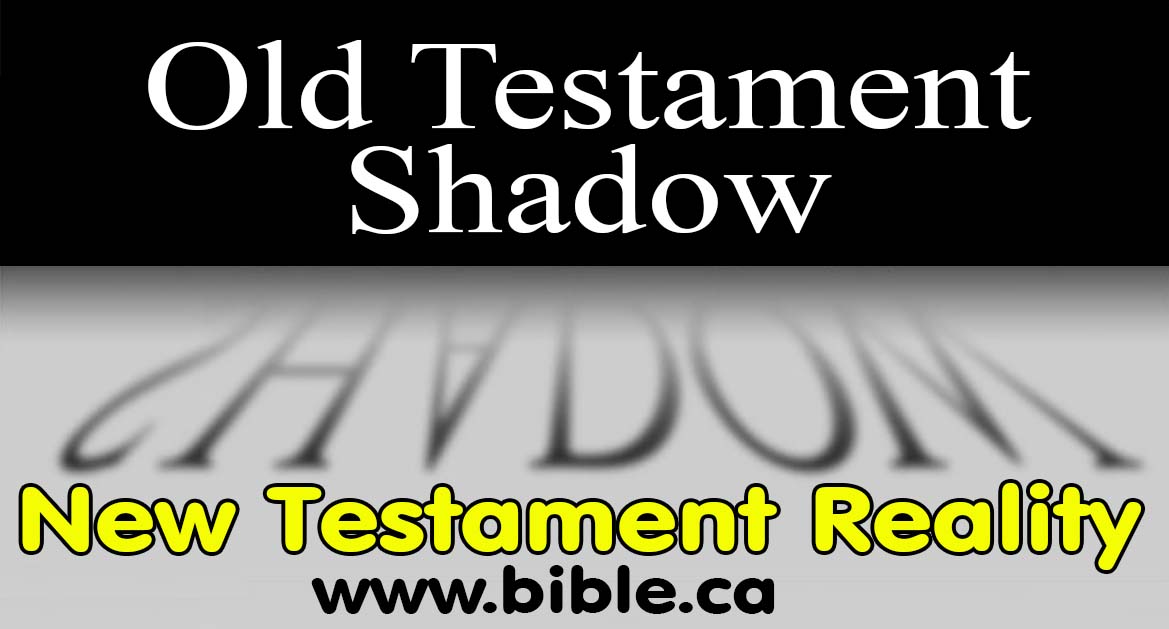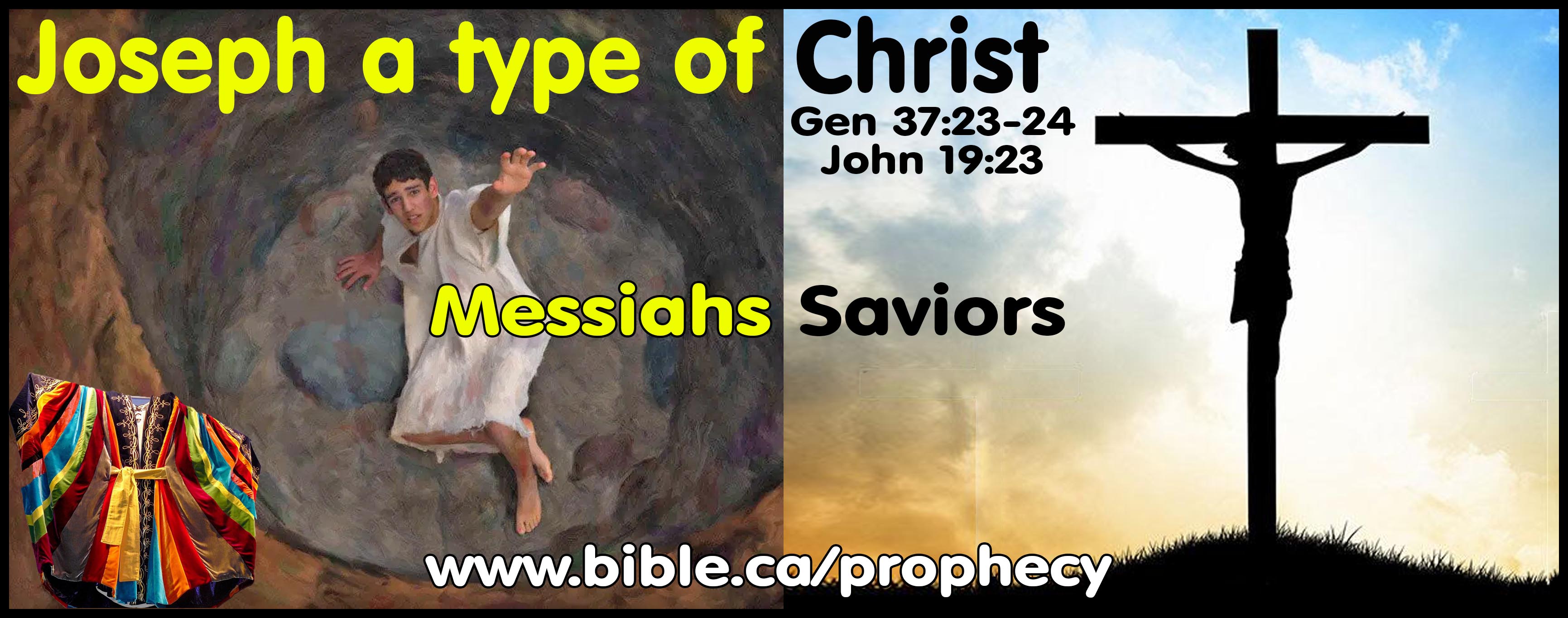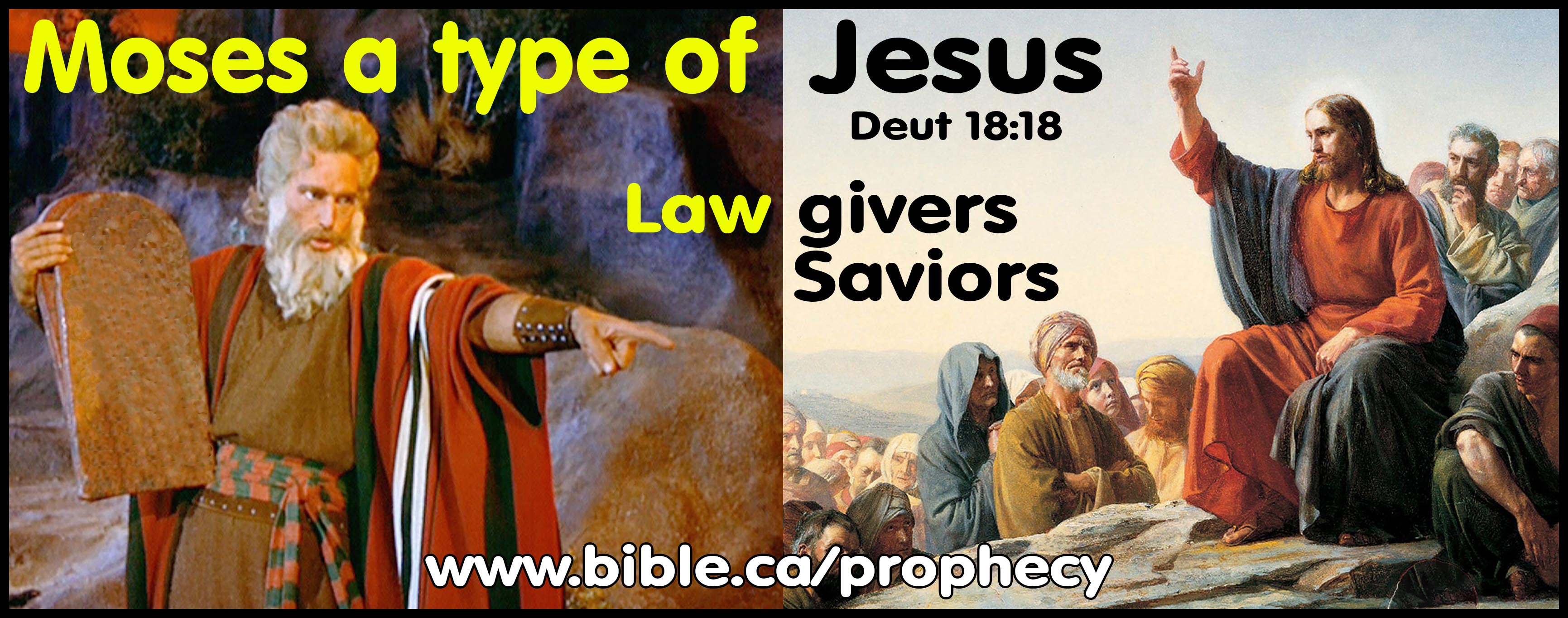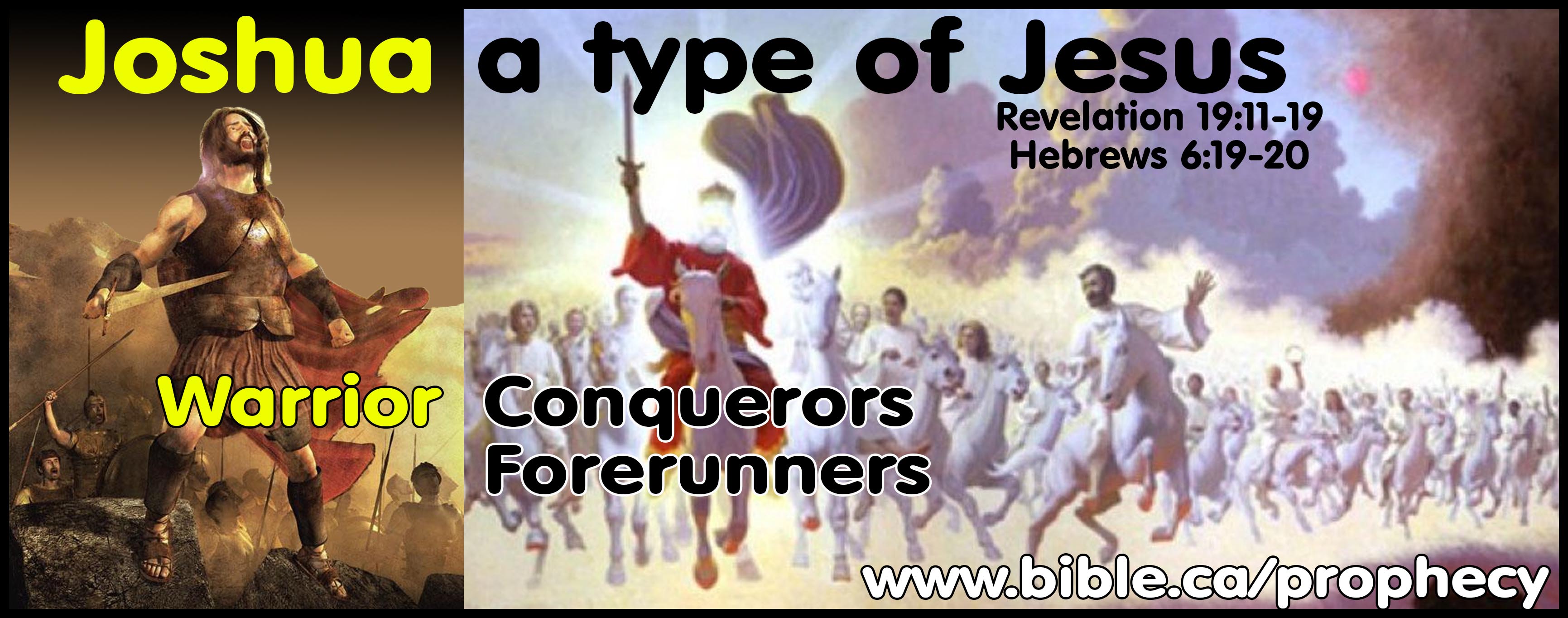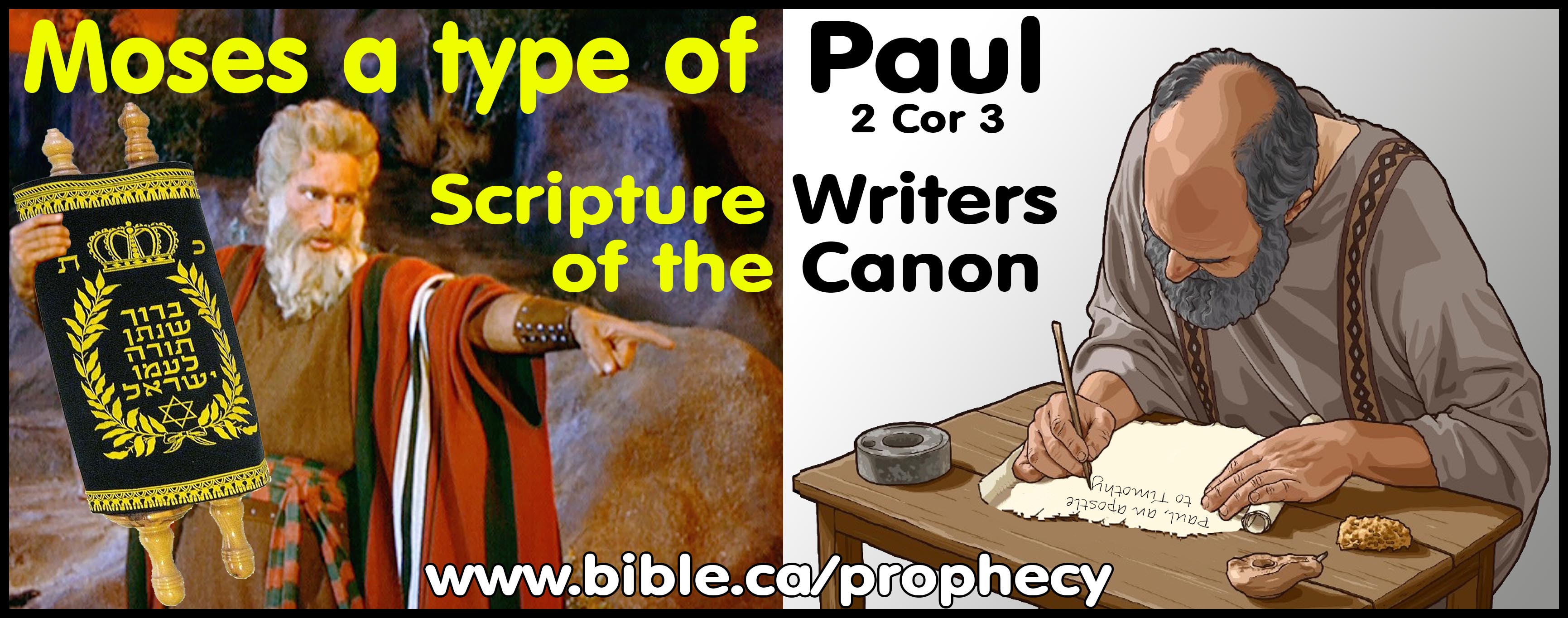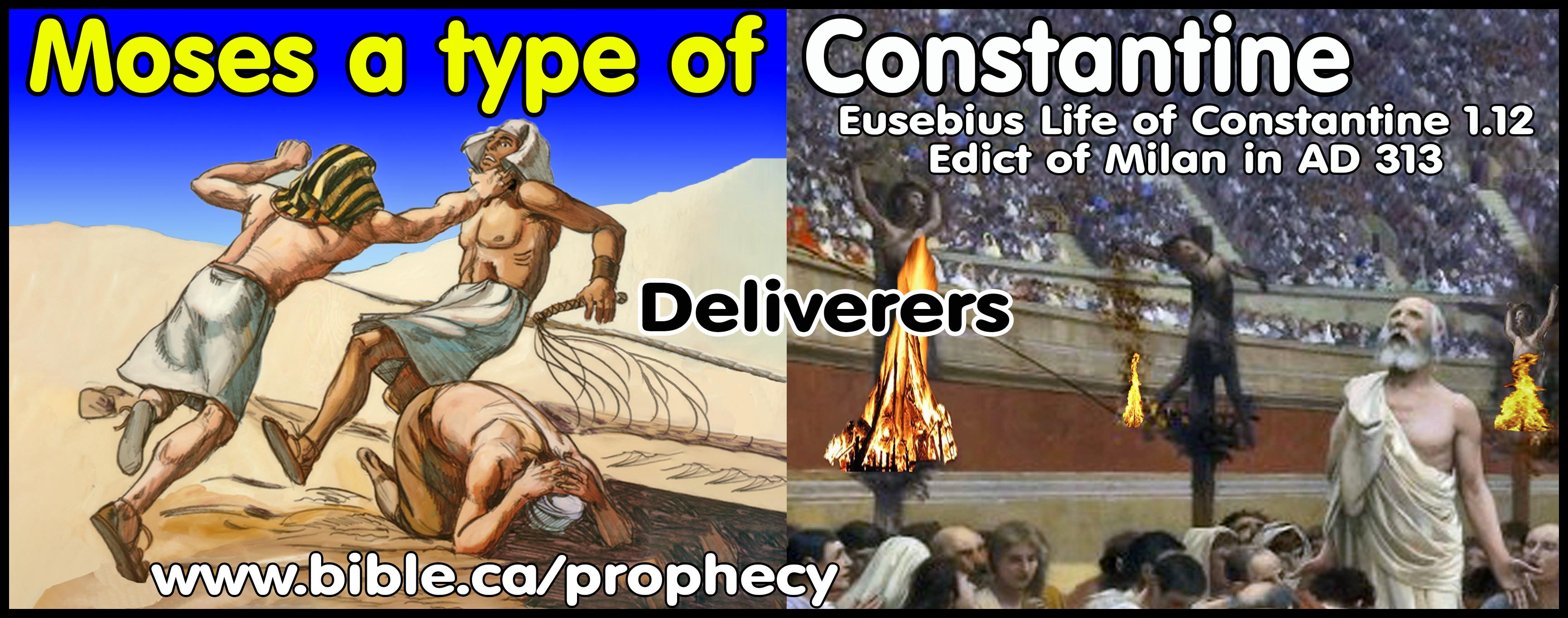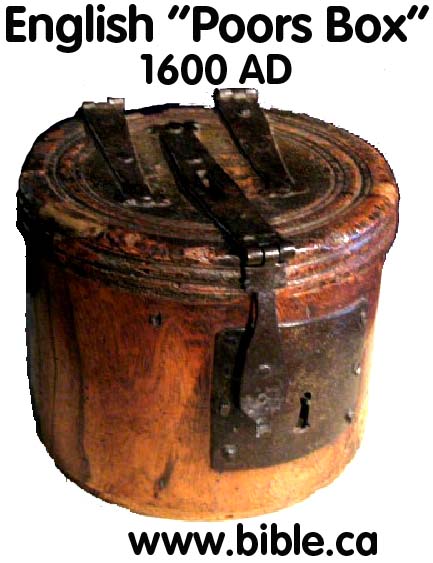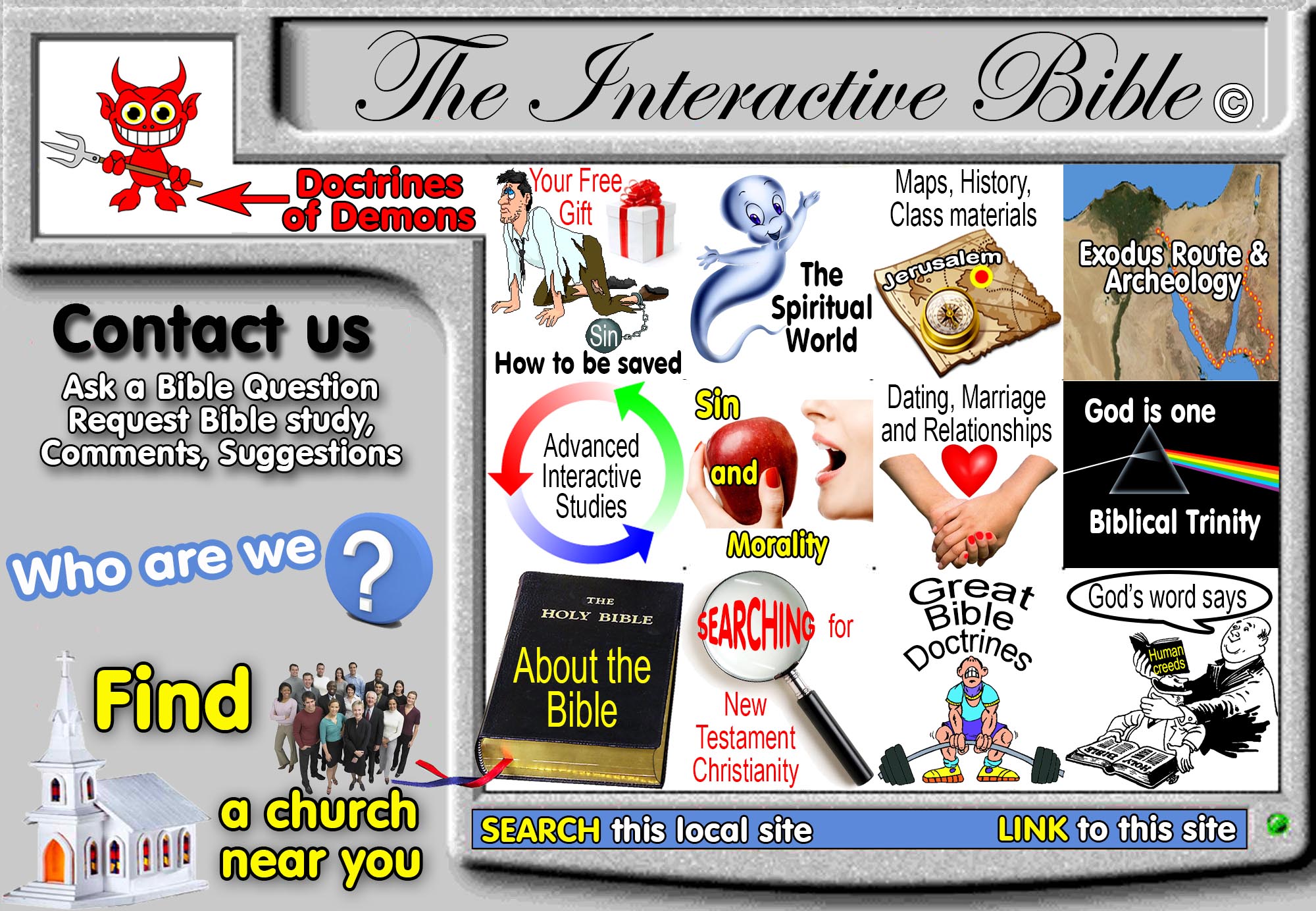Bible Prophecy Fulfilled through Jesus the Messiah
Introduction to Midrashic Prophecy and Fulfillment.
I. Using the Midrashic Hermeneutic to establish Bible authority in the Church.
II. Master Classification Catalogue of Midrashic Bible Prophecies.
III. Jewish Messianic Expectation at the time of Jesus’s birth.
IV. Messianic Expectation witnessed in Dead Sea Scrolls and Judean coins.
The Main Exhibit of Specific Bible Prophecies and their Fulfillment.
The Main Exhibit of Specific Bible Prophecies and their Fulfillment.
|
The Exodus
|
Tabernacle Prophecy
|
Exodus/Christian Election |
|
The Virgin Birth
|
A Child will be born
|
The Suffering Servant
|
|
Subjection under his feet
|
Jonah and Jesus
|
|
|
A King builds the Temple
|
He shall be called a Nazarene
|
Heaven and Earth shaken
|
|
Destruction of Temple
|
Abomination of Desolation Daniel 9; Daniel 11; Daniel 12
|
Olivet Discourse
|
|
Baptism Reenactment Rituals
|
Origin of Baptism
|
Communion Reenactment Rituals
|
|
Descension and Ascension
|
God the Rock of Moses
|
The Begotten Son
|
Shadows, Types and Antitypes
|
|
|
|
Joseph as a type of Jesus “Messiah Saviors” Gen 37:23-24; Jn 19:23 |
|
|
Moses as a type of Jesus “Lawgivers” Deut 18:18 |
|
|
Joshua as a type of Jesus “Warrior Conquerors” “Forerunners” Rev 19:11-19 Hebrews 6:19-20 |
|
|
Moses as a type of Paul “Scripture writers of the canon” 2 Corinthians 3 |
|
|
Moses as a type of Constantine the Great “Deliverers” Eusebius Life of Constantine 1.12, Edict of Milan AD 313 |
“Remember the former things long past, For I am God, and there is no other; I am God, and there is no one like Me, Declaring the end from the beginning, And from ancient times things which have not been done, Saying, ‘My purpose will be established, And I will accomplish all My good pleasure’" (Isaiah 46:9-10)
Introduction to Midrashic Prophecy and Fulfillment:
1. All messianic prophecies fall into three broad categories:
a. Texts that were universally recognized as predicting a single, clearly defined future messianic event at the time they were written. These texts can be used a proof that the Bible is inspired. The event prophecy of the rise of 5 kingdoms in Daniel 2 and the time prophecy of the arrival of the Messiah in Daniel 9 are two examples.
b. Texts that were prophetic of a specific event that was fulfilled shortly thereafter, but later understood to be a dual prophecy also fulfilled in Jesus the Messiah. One example is 2 Sam 7:14 which predicted that the son of David would build the temple, was first fulfilled in Solomon, then later by Christ. A second example is the prophecy in Isa 7:14 of the maiden giving birth to the Emmanuel child which was first fulfilled in Isaiah’s own son then also by Mary who gave birth to Jesus.
c. Texts that nobody understood to predict future messianic events until after they were identified in the New Testament as having been fulfilled. Taken by themselves, there is no indication they were prophetic in any way. These texts can be used as a proof of God’s foreknowledge by causing two historical events centuries apart to mirror one another. The two historic events are based upon well-established history making the typology obvious for all to see. Matthew 2:15 assigns messianic features to God calling Israel out of Egypt in 1446 BC during the Exodus which was a type of Joseph bringing Jesus out of Egypt in 1 BC.
2. Biblical/Jewish/Rabbinical Midrashic Hermeneutic Interpretation method is what Christians call “Necessary Inference”:
a. What Christians today call “Necessary Inference” is identical what first century Jews called “Midrashic interpretation”.
b. Midrashic hermeneutic is the term in the Bible and by Rabbinic Jews for “necessary inference”. Bible authority is established by obeying the silence of God, Command, example, and necessary inference also called Midrashic hermeneutic.
c. A hermeneutic is a generic term for one of many ways of interpreting the Bible. The Midrash Hermeneutic is one specific method of interpreting the Bible and was the one used by used by Jesus, the Holy Spirit, Old Testament prophets and inspired New Testament writers.
d. The clearest examples of Midrashic Hermeneutic method are the Gospel of Matthew, Paul’s writings and especially the book of Hebrews (written by Paul).
e. The Olivet Discourse becomes a triple prophecy using the Midrashic Hermeneutical method of first, the Christ coming in his kingdom on Pentecost AD 33, second, the coming of Christ in destruction in AD 70 and third, the “second coming” in Judgement at the end of time. Many elements of the Jesus’ prophecy in Matthew 24 are dual prophecies of both the coming of the Lord in Judgment in AD 70 and the future second coming. Our modern thinking wants to identify each verse in Matthew 24 as speaking either of the destruction of Jerusalem in AD 70 or the future second coming but this is impossible with most Midrashic prophetic messianic texts. The final product is a nice neat list of two sets of verses, each applying to two separate events. The error of this approach is becomes evident when you try to do the same thing in the dual prophecies of Isaiah 7:14; Isaiah 53 and 2 Samuel 7:14. The correct approach is to view all of Matthew 24 as a dual or triple prophecy.
f. Ezekiel was dual prophecy of the destruction of Jerusalem in 587 BC and AD 70. Revelation itself is an exact chapter by chapter, thought by thought remake of the book of Ezekiel. The Midrashic Hermeneutic allows us to use Ezekiel to decodes Revelation.
g. Modern Jewish Rabbis use the Midrashic hermeneutic in their synagogues and are intimately familiar with it. When Jewish Rabbis today are critical with the way Matthew connected messianic prophecy in the Tanakh to Jesus of Nazareth, they are being hypocritical because their own methods seen in their own rabbinical writings are many times more spatial, abstract and speculative.
h. Midrash is how Christians today determine faith and doctrine in the church which includes obeying the silence of scripture, direct command, approved apostolic example and inference as witnessed in how the Christians in Acts 15 refuted the need for the gentiles to be circumcised to be saved.
3. After AD 70, Rabbinical Judaism used the Midrashic hermeneutic method in writing the Mishnah (AD 200), the Tosefta (AD 250), Jerusalem Talmud (AD 400) and the Babylonian Talmud (AD 500). As Pharisaic legalism increased after AD 70, Rabbinical Midrash became increasingly mystical, imaginative and speculative in order to create new rules used by Jews today to maintain ritual purity, kosher and Sabbath compliance. This was misguided because Midrashic inference cannot change the substance of revealed commands. Midrashic interpretation led the Jews to wrongly create the Korban laws which Jesus identified as contradicting scripture (Matthew 15:3-9).
a. Boiling a goat in its mother’s milk was prohibited (Exodus 23:19). Kosher laws today prohibit the consumption of any dairy product for the evening meal or any mammal meat product for breakfast, lest the law is violated. Moses never outlawed drinking the milk of the mother goat, while eating the kid goat that had been roasted in fire. Midrashic interpretation extended the law not only to prohibit consuming any goat milk with any goat meat, but to outlaw consuming any kind of milk with any kind of red meat (mammal).
b. Kindling a fire on the sabbath (Ex 35:3) was prohibited Automatic programmed elevators on Sabbath days that stop at every floor so that law is not violated when a spark is created when the elevator button is pushed. (But a Jew will ride an elevator if a Gentile pushes the button.) All engines are outlawed on the Sabbath because they have spark plugs that generate a fire inside the cylinders. (But a Jew will ride in a bus driven by a Gentile) Its prohibited to change the thermostat temperature of your house because you are “kindling a fire” but its ok to set the thermostat before the sabbath and let the Thermostat “kindle the fire” hundreds of times a day as it cycles the furnace off and on. Midrash hermeneutic is the interpretation method used by the Jews in creating these laws but the reasoning is hundreds of times more spatial and speculative than the Midrash of the writers of the New Testament.
4. Midrash is a hermeneutic used in both the writing and interpretation of the Bible:
a. The Holy Spirit used the Midrashic hermeneutic when He inspired men to write the 66 books of the Bible:
b. Ezra used the Midrashic hermeneutic when studying the Law: "For Ezra had set his heart to study (Hebrew: drs = midrash) the law of the LORD and to practice it, and to teach His statutes and ordinances in Israel." (Ezra 7:10)
c. The Book of Kings (1st and 2nd King) was written by Jeremiah using the Midrashic hermeneutic: "As to his sons and the many oracles against him and the rebuilding of the house of God, behold, they are written in the midrash (Hebrew: mdrs = midrash) of the Book of the Kings. Then Amaziah his son became king in his place." (2 Chronicles 24:27)
d. Inspired prophets used the Midrashic Hermeneutic: "Now the rest of the acts of Abijah, and his ways and his words are written in the midrash (Hebrew: mdrs = midrash) of the prophet Iddo." (2 Chronicles 13:22)
e. Countless examples of New Testament writers quoting Old Testament passages and applying them using the Midrashic Hermeneutic method.
f. Jesus interpreted scripture using the Midrashic Hermeneutical Method.
5. Midrash was used by ancient Jews:
a. The Dead Sea Scrolls used the Midrash Hermeneutic:
b. Midrash used in Qumran library: “Mdrš conveys a variety of meanings in the literature from Qumran. It refers to judicial investigation, study of law, and interpretation. Although mdrš alone does not necessarily refer to biblical interpretation when it appears by itself in the Qumran texts, when it is used in connection with a verse from Scripture it does seem to have a more comprehensive meaning than either pyrwš or pšr” (ABD, Midrash)
c. Misha and Talmud used Midrash Hermeneutic: “Although in the rabbinic corpus mdrš may mean study or inquiry in a general sense, its main use in these documents is to designate Scriptural interpretation. In the rabbinic collections the term signifies both the process whereby Scripture is expounded and the product of that exegesis.” (ABD, Midrash)
6. Jews who dismiss New Testament fulfillments are often both ignorant and hypocritical:
a. The interpretive methods used by modern Rabbis in the Tanakh is far more spatial and speculative than any of the New Testament writers who used the Old Testament to prove Jesus was the Messiah.
b. Hypocritical: Jewish Rabbis activists like Tovia Singer are being hypocritical when they are critical of the way Apostle Matthew connected the Tanakh to the events in the life of Jesus Christ because he knows the Mishna, Tosefta and Talmud are 100x more speculative and nuttier on every page than anything he attacks Matthew for doing. Anti-Christian Jewish Rabbis who crusade against how the New Testament finds messianic fulfilment in the Tanakh, use arguments that destroy also their own Mishna, Tosefta and Talmud. Any argument they use to destroy the New Testament also destroys the Old Testament (Tanakh). The arguments used by modern Jewish Rabbi anti-Christian crusaders like Tovia Singer who attack messianic prophecy in the New Testament are identical to how atheist Bible-trashers attack prophecy within the Old Testament.
c. Ignorant: Jewish Rabbis who are ignorant of the Midrashic interpretation method and challenge how New Testament writers found fulfillment in Old Testament prophetic texts are being very “unjewish” because they are applying their modern rational thinking over top of a first century Jewish Midrashic hermeneutic style.
d.
For example: There is no
indication in Num 24:17 that this is a messianic prophecy, yet all first
century Jews understood it to be a messianic prophecy because the Prutah of
Alexander Jannaeus (Widow’s Mite) featured the messianic star. This was the
most common coin in wide circulation at the time of Jesus and was universally
understood to be based upon Balaam’s prophecy. Bible Trashers borrow the
approach of Tovia Singer by arguing it is not a messianic prophecy because it
could easily be viewed as being fulfilled by either king David and Solomon.
Modern Rabbis must reject the messianic interpretation of Num 24:17 that all
their first century brothers both believed and taught if they reject the manner
in which Apostle Matthew applied messianic prophecy.
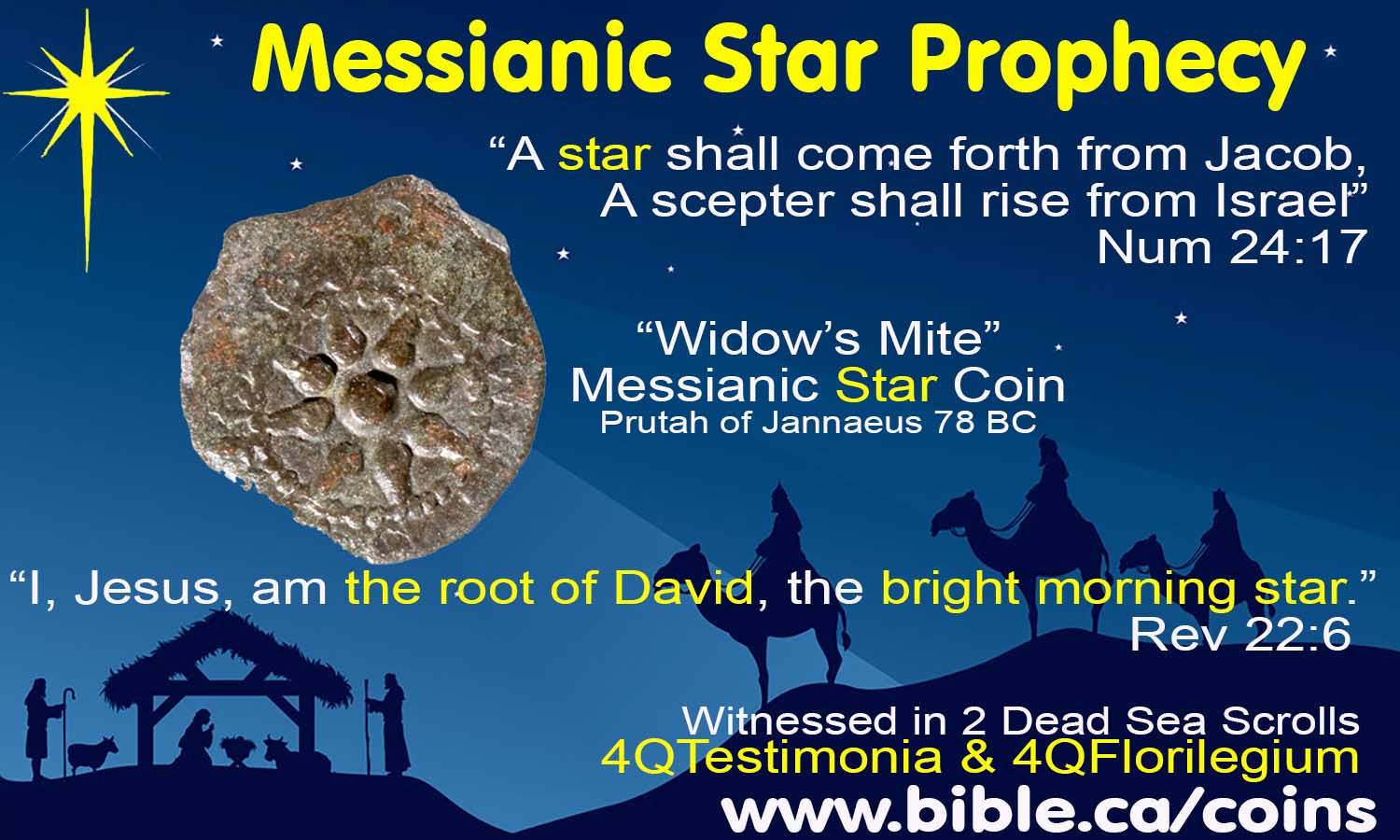
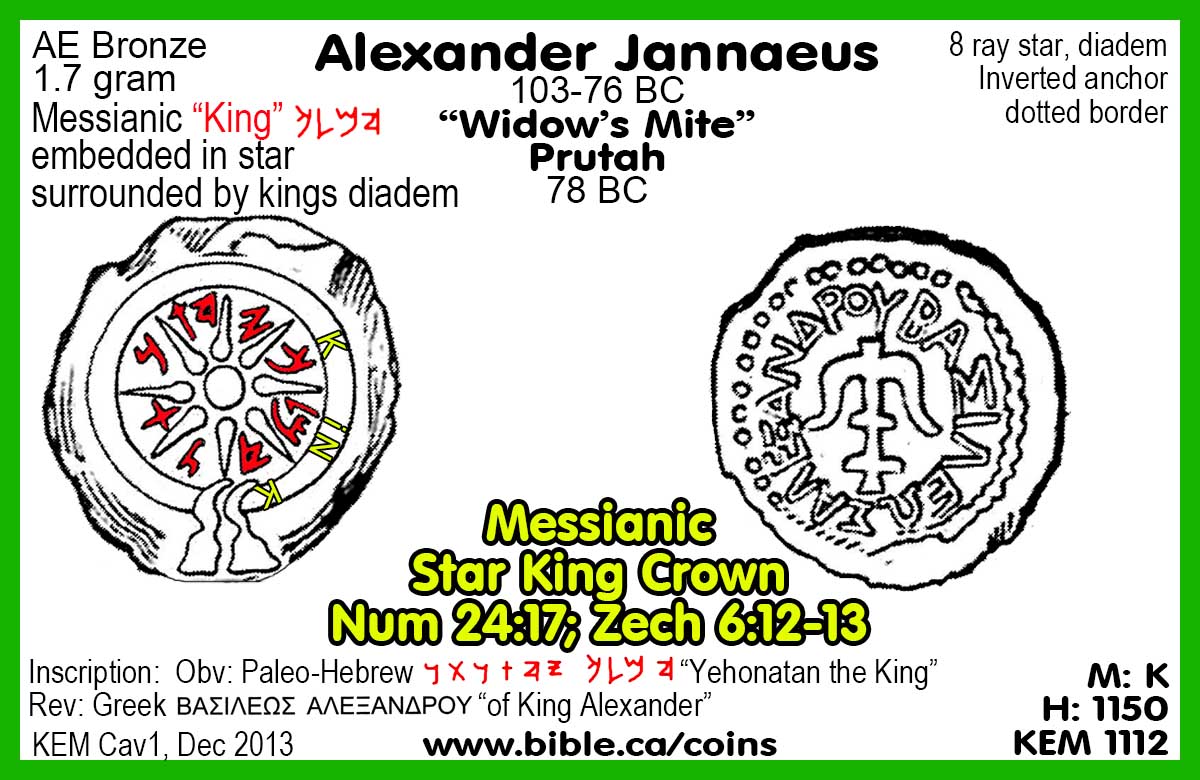
7. Most Christians are completely unaware of the Midrashic style of interpretation of Messianic prophecy used as a hermeneutic in the New Testament for their fulfillment. While command, example, inference and obeying the silence of scripture is true and valid hermeneutic in determining morals, doctrine and liturgy, this system is almost irrelevant in decoding Messianic prophecy in the New Testament.
a. Many Christians, including Full-Preterists, apply flawed 21st century black and white hermeneutical thinking (Epistemology, John Locke, René Descartes etc.) to interpret ancient Jewish messianic prophecy written in the Midrashic style.
b. Most Christians today expect prophecy to be clearly predictive of a future event, that when fulfilled, is obvious without need of explanation but that is not how the Holy Spirit designed most Messianic prophecy.
c. Most Messianic prophecies become obvious only after the fact of fulfillment.
d. Some Christians only accept messianic prophecies that are clearly indicated as such in the New Testament. These will reject all character antitypes as coincidence and unworthy of any pulpit time discussing. These reject as coincidence the 75 clear parallels, echoes and antitypes between Joseph and Christ, 25 between Moses and Paul and 40 between Elijah/Elisha and John/Christ. Since none of these antitypes are specifically identified as such in the New Testament, these Christians conclude they are invalid or wild speculation. Yet most of the central messianic prophecies were fulfilled in much looser terms and less obvious specifics than these dual character types and antitypes. If they reject these antitypes, they would also need to reject many of the messianic prophecies which are founded on character and historical parallels not viewed as messianic until after the resurrection of Christ. Just as the apostles looked back, after the fact, and saw messianic parallels in both men of old and history, so too we need to be alert that the entire history of the world is the result of God’s direction, power and choice. Historical events, therefore were often directed by God in such a way to lay down patterns that become obvious to Christians which the Jews were unable to see before the time of Christ.
8. Messianic prophecy generally required a Midrashic style of interpretation to understand:
a. As seen in the four Synoptic gospels, the Midrashic style often ignores chronology or reverses chronology to make a thematic point.
b. As seen in how New Testament writers quoted Old Testament texts, the Midrashic style will pull together a series of seemly unrelated events or Bible texts to make a thematic point.
c. As seen in how New Testament writers quoted Old Testament texts, the Midrashic style changes, updates or deletes words and phrases to make a thematic point.
9. The Midrashic style allowed God to record messianic prophecy in such a way so as to keep the actual meaning as hidden mystery until the Messiah, Jesus came.
a. While a small handful of Messianic prophecy are effective proofs of Bible inspiration, the vast majority of Old Testament Messianic texts cannot be used in this way.
b. The Holy Spirit designed that most messianic prophecies were deliberately vague in order to keep future events a mystery before they happened, but clearly prophetic after they happened. Many New Testament Passages speak of how the mystery of the Old Testament was now made known in the New Testament long after the events were fulfilled by Christ.
c. Jesus often pointed out how event in his life specifically fulfilled Old Testament prophecy which surprised his listeners.
d. The power of messianic prophecy is not only clearly predicting a future event before it happens, but also looking back after the fact and seeing how two major Bible events are synchronistic.
e. This is how the Holy Spirit wrote the entire Bible.
I. Using the Midrashic Hermeneutic to establish Bible authority in the Church:
1. The Holy Spirit’s hermeneutic in establishing Bible authority is revealed in Acts 15. When Jewish Christians began speaking where God was silent in demanding the gentiles be circumcised in order to be saved, the silence was restored by Peter, Paul and Barnabas and James in the letter they sent out to the Gentiles.
a. Peter used “inference” by arguing if the Holy fell upon the Gentiles without circumcision then they could be saved without circumcision. We use inference to determine that Christians are to not only assemble every Sunday, but are also to partake of the Lord’s supper based upon Acts 20:6 and 1 Cor 16:2. Inference is an example of the Midrashic hermeneutic.
b. Paul and Barnabas used “approved apostolic example” by describing how they have saved thousands of Gentiles without circumcision and the Holy Spirit continued to perform miracles to confirm their work was approved.
c. James used “direct command” by quoting Amos 9:11 as a messianic prophecy of when the tabernacle of David was rebuild (i.e. the church on AD 33) the gentiles would be included.
d. False teachers had spoken when God was silent and began demanding circumcision as a requirement of salvation. The use of command, example and inference restored that silence. Notice that in the letter sent out to the Gentiles regarding their salvation without circumcision, it did not say, “circumcision is not required”. Instead it restored the principle of silence and told them four things they needed to do. This is why we speak where the Bible speaks and are silent where the Bible is silent.
2. The letter sent out to the Gentiles (Acts 15:19-29) was clearly Midrashic Hermeneutical in that it listed four laws for the Gentiles only to obey:
a. Since the silence of God was broken by commanding the Gentiles to be circumcised, even though circumcision was an Old Testament covenantal requirement. The Jews had mistakenly inferred the Gentiles must also be circumcised, but this kind of inference was common among first century Jewish and Christian thought. The Jerusalem conference was to determine one thing: Do the Gentiles need to be circumcised to be saved or not? When the Gentiles read the letter which the Jerusalem had written, the first thing they noticed is that the subject of Gentile circumcision is not even in the letter. They might have thought, “These guys go to Jerusalem to determine if we Gentiles need to be circumcised and they send of the decision/judgement letter that doesn’t even discuss the central issue of debate.” The letter is indeed seeming puzzling and irrelevant to the topic at hand. If you for example, if you apply to the city for a building permit for a new house and they issue you an occupancy permit for the house you are already living in, you would want your $50 bucks back. If you ask for a hamburger at the drive through, and you find out when you get home, they give you a salad, you know a mistake has been made. In the same way, if the only purpose of the Jerusalem council was to determine if the Gentiles needed to be circumcised and the written legal instructions that come back are completely silent on the topic, but instead issue four laws that you did not ask them to discuss, you would think they failed at their job! Until you understand the principle of obeying the silence of God as a core principle of Bible authority. The Jews has broken God’s silence by ordering Gentile circumcision and the Holy Spirit RESTORED God’s silence by telling us what we need to do. God expected his silence to be obeyed by not adding new things he spoke nothing about in order for us to be saved. God told us what we need to do to be saved namely; faith, repentance, confession and water baptism (Mk 16:16; Acts 2:38; 22:16; 1 Pe 3:21) God did not need to say all the things we DO NOT need to do to be saved. On the day of Pentecost when the Jews asked, “what do we need to do to be saved” God did not reply, “repent and be baptized to be saved but you don’t need to be circumcised”. Instead God told us to repent and be baptized and he expected us to obey his silence by not adding a new requirement like circumcision. One additional point is that instrumental music in church worship is prohibited on exactly the same grounds as gentile circumcision. Both were commanded in the Old Testament, but God is silent on both in the New Testament. All nine times Christians are commanded to “sing” not play instruments. Instrumental music was banned in all first century Jewish synagogues and the Orthodox church has practiced acappella worship without instruments from Pentecost down to the present. The Roman Catholic church introduced instrumental music in AD 790 in one church, which let to the churches severing into two different communions of fellowship in AD 1054. All the great church reformers opposed instrumental music in worship and no protestant church used instrumental music before AD 1750. Today’s ultra-liberalism in the Christian church looks at churches who teach instrumental music is forbidden a pharisaical, when it is them, who are in fact worshipping in violation of God’s law by not understanding that God’s silence must be obeyed. God tells us what we must do and the rest is prohibited, like circumcision and instrumental music. This is why the letter sent from Jerusalem to the Gentiles did not even mention circumcision because God was restoring the principle of obeying God’s silence.
b. Only fornication is a black and white moral issue, while the other three are Jewish Kosher laws.
c. While the letter prohibits eating meat sacrificed to idols, Paul later (1 Corinthians 8:7-13) clearly states that it is not a sin to eat meat sacrificed to idols in some circumstances.
d. Specifically, there is nothing in the New Testament that prohibits even the eating of blood, given Christ cleansed all foods but this was wisdom advice to help new Gentile Christians escape a past life of idolatry.
e. The three kosher laws commanded in Acts 15 for Gentiles, even after all kosher laws were formally abolished at the cross, are perfect examples Midrashic Hermeneutic created for a special purpose at in unique times.
3. Summarizing Bible authority in Acts 15:
a. God’s law of silence was broken by ordering the Gentiles to be circumcised.
b. James used “direct command” by quoting Amos 9:11 to prove the gentiles did not need to be circumcised.
c. Paul and Barnabas used “approved apostolic example” in that none of his converts were circumcised.
d. Peter used “inference” because the Holy fell uncircumcised Gentiles.
e. The letter sent to the gentiles restored the principle of silence by only listing what was required, not what was not required.
4. Paul used Midrashic Hermeneutic in his personal advice in marriage and divorce in 1 Cor 7.
a. 1 Corinthians 7:10-11: First, he prohibits a wife divorcing her husband for “no cause”, then goes on to say if she does divorce him, she must remain unmarried or remarry her husband. None of this Midrashic advice changes the fact that you are not permitted to remarry without first divorcing your wife for fornication in Mt 19:9, it just enters the “grey zone” of what to do in special circumstances. Because “God hates divorce” (Mal 2:16) Midrashic hermeneutic appears to advise that it is sinful to divorce for no cause but in doing so you have not committed the greater sin adultery. Some Christians today conclude that the act of divorce alone is permitted as a non-sinful action if you remain single the rest of your life. Paul’s Midrashic interpretation comments on the degrees of action and their associated sins in the absence of specific law in these specific circumstances. If a woman has already committed the lesser sin (or unwise choice as some say) of no cause divorce, don’t make it worse by then remarrying and also committing the greater sin of adultery against your first husband. This kind of Midrashic interpretation by Paul under the inspiration of the Holy Spirit illustrates the hermeneutic of the Apostolic church and the general Jewish mindset of the day. Christians today are all familiar with debates regarding divorce and remarriage that begin with clear stated law in specific cases that must employ Midrashic inference to determine the will of God in the myriad of “but what if” cases. This does not mean we cannot know the will of God all these cases, just that we must move from “thus sayeth the Lord” into the arena of “inference”, both of which are equally valid hermeneutical tools in establishing Bible authority.
b. 1 Corinthians 7:25-38: In the previous case, Paul discussed a lesser and greater degree of sin in no fault divorce, but next Paul argues for a lesser and great degree of righteousness in celibacy. Paul recommends against singles getting married at all, given the tribulations Christians were enduring and about to endure under the 3 ½ year persecution of Nero in Rome. Then Paul goes on to say singles have the liberty to marry if they want. Again, Paul’s advice to fathers in “doing well vs. doing better” (1 Cor 7:38) is an example of Midrashic hermeneutic.
c. 1 Corinthians 7:25-38: Paul’s advice to widows to remarry only a Christian follows the pattern of advice in the chapter of multiple permitted choices. Remaining an unmarried widow is best, marrying a Christian is good, marrying a non-Christian is legal but a bad choice. Unlike the previous cases, in 1 Cor 7 Paul leaves it up to the reader to infer through Midrashic hermeneutic that it is permitted for a widow to marry a non-Christian (Rom 7:1-3), but that it is a very poor choice. This inference draws upon applying a Midrashic interpretation of the prohibition of Jews to marry Gentiles under the Law of Moses (Deut 7:3) which then goes on to lay down ground rules when a Jew wants to marry a Gentile, with the 30 day (sexless) trial marriage (Deut 21:10-14). To complicate matters, the reader must determine if Paul’s unqualified prohibition for widows to marry non-Christians is new legislation that changes Mosaic law or if it merely echoes mosaic law. This is a perfect example of where Paul leaves it up to the reader to infer that a widow marrying a non-Christian is permitted by God, but a poor and unwise choice that will probably cause you trouble, grief and possibly your soul (Josh 23:12-13). We learn that God allowed Jews to marry gentiles in the Law of Moses, and the prohibitions are warnings of how the woman will lead the Jew to eternal destruction through the practice of idolatry. Jews could marry non-Jews and Christians can marry non-Christians and all the prohibitions are not black and white laws against the marriage itself, but warnings of how such a lifetime union will lead ones’ soul to hell.
5. Inference is Midrashic: As one of the three methods of establishing Bible authority, inference is close to, but not identical with the Midrashic hermeneutic which Jesus, Matthew, Peter, Paul and John used.
a. Types and shadows of old testament characters fulfilled in the messianic age not specifically identified in the New Testament. There are over 75 ways that Joseph is a type of Christ. There are 25 ways that Moses was a type of Apostle Paul. There are over 40 ways that Elijah was a type of Christ and Elisha was a type of John the Baptist. There are 15 ways that Abraham was a type of Christians. In all these, no new doctrine or event is created. The lives of two Bible characters are recorded in scripture and are found to have parallels. God’s power and foreknowledge was able bring about specific events in the first character, with a view to it being echoed in the specific life events of a second Bible character.
b. Misuse: Harold Camping and Chris McCann find what they think are parallels to predict the second coming of Christ over 15 times between 2011 and 2020 AD. They also began to teach that nobody could be saved after May 21st 2011 AD. This is a significant theological change from what scripture clearly records about salvation being available until the second coming of Christ.
c. Inferential Midrashic Hermeneutics will never teach something that contradicts theological principles directly established by direct command or direct statement in the New Testament. Fears about Midrashic Hermeneutics being a slippery slope of new doctrine are unfounded because it is just plain old inference.
6. We must have Bible authority for everything we do as Christians as a local church. Through necessary inference, we have Bible authority to use church treasury funds to build meeting halls, buy songbooks, and pay local preachers their wages. Christians who reject typology unless specifically identified as such in the New Testament through a “thus says the Lord” bible verse, are logically driven into the dilemma of suddenly having no Bible authority for many things they practice. If they reject typology simply because there is no “thus says the Holy Spirit”, even though it is strongly inferred, they cannot suddenly use “necessary inference” for Bible authority to determine the frequency of Sunday assembly and communion, use local church funds to build assembly halls, buy songbooks, pay local preachers, buy advertising for local evangelism and pay for supplies for Sunday schools classes. There is no “specific authority” for any of these, but they are all authorized on the basis of being “necessarily inferred” through “generic authority”. If you reject all typology because they are inferences, you cannot ever use inference for anything else either! Those who reject all inferred typology, but lack a “thus says the Holy Spirit”, have pulled the rug out from underneath themselves in having no Bible authority for church buildings, songbooks, paying local preachers or spending money on local evangelism and Sunday school class supplies out of the local church treasury. Sure, they can raise private donations but lack authority to use the Lord’s treasury. The approved pattern of the Holy Spirit of looking back to the Old Testament for types, leads us to “necessarily infer” that we can likewise look for additional types not identified by the Holy Spirit.
a. Christians who reject typology unless specifically identified as such, have no authority for the weekly frequency of Sunday assembly and communion because it is based upon “necessary inference”, which is the Midrashic Hermeneutic. Acts 20:7 is the only recorded Sunday worship service in the New Testament by way of example. Using the logic that “if the text says they met on the first day of the week to break bread, that they met EVERY first day of the week to break bread” is an example of a classic Midrashic hermeneutic interpretation, and it is correct! Establishing Bible authority through “approved apostolic example” of Acts 20:7 of a Sunday communion worship service, leads us to “necessarily infer” that they met and communed “every” Sunday. There is no other way to establish the frequency of assembly and communion except through necessary inference alone. There is no pattern in the Old Testament for weekly assembly of God’s people. Weekly sabbath assemblies in Synagogues began in 280 BC in Alexandria and are never referenced once of the Old Testament. Even if they did, it would require in inference through typology to connect weekly synagogue services to weekly church services. While 1 Cor 16:1-2 proves a weekly freewill collection into a central common treasury, it does not necessarily infer an assembly to do such because a man could go house to house each Sunday to collect the donations.
|
Alternately, individuals could walk to an agreed upon location where money would be dropped into a donations box as practiced in the Jewish Temple and the medieval church “Poors Box’. 1 Cor 16:1-2 says nothing about a weekly assembly. Through inference we concluded that Paul’s readers assumed the weekly collection was taken during the weekly assembly when they partook of the Lord’s Supper. It is logically inconsistent to preach a weekly frequency of assembly and communion through inference alone, as codified New Testament law, but reject all 75 ways that Joseph was a type of Christ, because Joseph is never specifically identified as a type of Christ in the New Testament. Neither the weekly frequency of Sunday assembly nor the Joseph/Christ typology have any specific authority that undergirds them but are established solely on the basis of inference. |
b. Christians who reject typology unless specifically identified as such, cannot use generic authority to authorize the use of church treasury funds for songbooks and church buildings. Generic authority correctly infers and assumes, that we can use church treasury funds to purchase anything needed to fulfill commands given to a local church collective. The specific command to sing authorizes songbooks (Eph 5:19) using Midrashic hermeneutic. The command to assemble authorizes church buildings (Heb 10:15) using Midrashic inference hermeneutic. Creating law in the absence of specific revelation through generic authority is classic Midrashic the apostles were familiar with. Establishing Bible authority through specific authority is “thus says the Lord’. Establishing Bible authority through “general authority” always requires inference because while the specific command to assemble authorizes through “general authority”, the use of a physical meeting facility, we must infer that it is permitted to use church treasury funds to build a church building, as opposed meeting in homes for free or individuals donating materials and labour. While we are authorized to use church buildings and songbooks, scripture never tells us where the funds come from, and we must infer that we can spend local church treasury funds. Indeed, several pre-AD 70 Jewish synagogue inscriptions memorialize single individuals, often women, who personally funded the building of the entire synagogue buildings. The individual is commanded to spend money on widows and orphans (Jas 1:27) but we are not told where the money comes from. We infer the individual spends his own money and it is wrong to spend funds from the local church treasury. Since the three specific examples of spending church treasury money is outside benevolence, outside support of gospel preachers and internal benevolence to qualified widows, we must infer that it is also acceptable to use church treasury funds to build church buildings. What further demonstrates the essentiality of inference in this case to authorize using church treasury funds to build church buildings, is that the three specific examples how to spend church treasury funds can be viewed as “excluding” all other specifics (like spending church treasury funds on building church buildings or songbooks etc). The “specific pattern” of churches being funded through weekly freewill offerings correctly “excludes other specifics” like raising church treasury funds through the practice of tithing, bake sales or church sponsored business ventures. Yet when it comes to spending church treasury funds, we use inference to override the principle that “specifics exclude other specifics” and infer that we can spend church treasury funds on church buildings and songbooks and paying the local preacher. Without “inference”, the “specifics” of spending church funds on outside benevolence, support of outside preachers and local benevolence of qualified widows, would “exclude” all other uses of the Lord’s treasury funds, including church buildings, songbooks, class supplies etc. The result is that those who reject types on the basis that it is inference, have no authority for their church buildings. You cannot use Midrashic inference hermeneutic to authorize the use local church treasury funds for social events and “fellowship halls” because there is no specific authority for the church to provide entertainment. Eating common meals in a church building is specifically forbidden: "If anyone is hungry, let him eat at home, so that you will not come together for judgment." (1 Cor 11:34) Everybody almost universally understands and uses the “crossing the Jordan = death” type as a clear truth through inference. It is logically inconsistent to deny that crossing the Jordan river by Joshua into the promised land was a type of death, i.e., “brother Brown crossed the Jordan last night after a long battle with cancer”, or singing the hymn, “On Jordan’s stormy banks I stand”, because it is not identified specifically as a type by the Holy Spirit in the New Testament, then buy songbooks and construct church buildings of local church treasury funds, for which there is also no specific authority and also requires inference.
c. Christians who reject typology unless specifically identified as such, have no authority for paying the local preacher from local church treasury funds or for Sunday school class supplies or local evangelism (i.e. advertising in newspapers etc.) because there is no command or example of paying for such activities out of the local church treasury and they are “authorized” only through “inference”. We have specific authority by way of command and example, for one local church giving money from their treasury to the elders of another local church for benevolence. We have specific authority by way of command and example, for local churches sending money from their treasuries to one local preacher of another church (Phil 4:16). There is only one command and example that authorizes a local church to spend their treasury funds and it is to benevolently support older dedicated Christian widows (1 Tim 5:9) in a highly restrictive way. The “specific” prerequisites and qualifications for putting local Christian widows on the “list”, “excludes” all other “specifics” from being put on the “list” like men, children, all younger widows, all lukewarm widows, and all new convert widows. The “list” instructions layout regular support payments from the church treasury to widows, could be viewed as “specific authority” that “excludes” all other “specifics” like one-time gifts from the church treasury to needy local Christians. Through inference alone, do we authorize one-time gifts to local needy Christians. There is no command or example of spending church treasury funds for any other reason, including local evangelism or paying the local preacher. Scripture mandates that “all things be done for edification/teaching”, so we “necessarily infer” that we can spend local church funds for supporting a local preacher, Sunday school classroom supplies and local evangelism, in the absence of specific authority. While Paul and Peter taught that preachers are to be financially supported by Christians (1 Cor 9:14; 1 Tim 5:17-18), we are not told if the financial support is directly between individuals or corporately from the local church treasury. Even 3 John 6-8, which commands the support travelling evangelists who visit, by “sending them on their way in a manner worthy of God”, we must infer the money comes from the local church treasury, as opposed to individual gifts. The expression “being sent on their way by the church” infers they were given money, but we are never told if the money comes from a church treasury or individual gifts and in all cases it refers to traveling evangelists, not paying a local preacher from the local treasury: (Acts 15:3; Rom 15:24; 1 Cor 16:6,11; 2 Cor 1:16; Titus 3:13). Even 1 Cor 16:1-2, taken at face value through specific authority, might even “exclude” all other “specifics” like paying the local preacher from the same church treasury because the “specific” purpose of the funds donated and the “specific” use of the money spent, was for benevolence alone, not evangelism for paying any preacher. Add to this, the only pattern we have is local preachers being supported by “outside churches” and have no command or example of a local church supporting their own local preacher from local church treasury funds. Only through “inference” do we find Bible authority for preachers receiving wages from the local church treasuries. It is logically inconsistent to claim Bible authority for paying the local preacher and buying class supplies by way of generic authority and “inference” to use local church treasury funds based upon “all things be done for edification/teaching”, then reject typology inferred by the “example” of the Holy Spirit. In a sermon on water baptism, it is logically inconsistent to use the tabernacle laver or Naaman as a type, or to say that being in Noah’s ark is a type of our salvation (the water is the type, not the ark itself), and then forbid as unscriptural, any typology unless the Holy Spirit has identified it as such in the New Testament.
d. Christians who reject typology unless identified in the New Testament are without Bible authority for a plurality of Elders/Bishops/Shepherds in every local church. In this case, there is no clear direct command that each local church have a minimum of two qualified men appointed. We establish Bible authority for a plurality of elders in every church based upon “apostolic example” alone. The closest to a direct command for a plurality of Elders is “appoint elders in every city as I (Paul) directed you” Titus 1:5. This could be taken to mean one elder in every church or at least two elders in every church. Only when you look at the uniform “approved apostolic example”, is it clear that Paul’s directive was for a plurality of elders in each local church (Acts 11:29,30; 15:2,4,6,22-23; 16:4; 20:17,28; 21:18; Jas 5:14; 1 Pe 5:1-3; 1 Ti 4:14; 5:17). Just as we use the “approved example of the Apostles” in determining each church must have 2 or more elders, so too we use the “approved example of the Holy Spirit” to connect types and patterns of similar events between the Old and New Testaments. The uniform pattern in 15 different Bible verses of two or more elders in each local church are as striking as finding a uniform pattern of 64 similarities of Moses as a type of Christ or 75 ways Joseph is a type of Christ. Both are established by example alone and both produce patterns that are so clearly by divine design, you would have to be “blind as a bat” to miss them.
II. Typology is Midrashic hermeneutic of Necessary Inference:
1. Most Christians are unaware that typology is the foundational cornerstone of how messianic prophecy is fulfilled throughout the Bible. While they accept Old Testament typology that is identified as such in the New Testament, it escapes their notice that most New Testament fulfillments reached back to passages that gave no indication they were prophecies. In other words, until the Holy Spirit identified these Old Testament texts as prophecies that were fulfilled on the New Testament nobody before that time viewed these passages as messianic prophecies or prophetic in any way.
2. Two extreme views of Bible typology:
a. The first extreme group rejects all types unless specifically identified as such in the New Testament. For example, these reject the pattern of 75 Joseph/Christ similarities as mere coincidence and believe it is wrong to refer to these parallels in sermons because they were not the product of divine providence or design. This group has determined it is heresy and “hogwash” to peach a sermon or gospel meeting that discusses the 75 ways that Joseph was a type of Christ as valid form of prophecy fulfilled. While railing against inferential typologies from the pulpit, they sing many songs during the Sunday worship service filled with typologies. “Avoiding Extremism: Others, though, feel that the use of types in the Scriptures is quite limited. Accordingly, one can only identify a type when the New Testament specifically does so. This is an extreme position. If one followed a similar line of reasoning, he might assert that there are no prophecies in the Old Testament save those which are specifically quoted in the New Testament.” (A Study of Biblical Types, Wayne Jackson, Christian Courier, p1)
b. The second extreme group finds types in every little similar detail or event. For example, while David’s rock of refuge is a type of the rock Moses struck and Christ himself as saviour, the 600 Benjaminite’s finding salvation and refuge on the rock of Pomegranates (Judges 20:47) has no connection as a type of the rock Moses struck or Christ. Philo of Alexandria and Augustine are a good example of finding allegory and types to the point of almost extreme. “Still another extreme is the notion that virtually every little detail of the Old Testament system was typical of some New Testament circumstance. Thus, even the cords and pegs of the tabernacle were seen by some commentators as representing significant antitype New Testament truths. The truth is to be found between these extremes.” (A Study of Biblical Types, Wayne Jackson, Christian Courier, p2)
3. All the major typologies specifically identified in new Testament reach back for their source to passages that had never previously been viewed as messianic or prophetic in any way. In each of these cases the Holy Spirit surprises us that all these Old Testament people and things were prophetic and typical for Christians. Had the Holy Spirit not pointed it out, we never would have guessed there was such a connection. A few examples the Holy Spirit directly identified as types include:
a. the Passover lamb as a type of Christ: 1 Cor 5:7
b. the Passover meal as a type of the Lord’s Supper: 1 Cor 5:8
c. Noah’s flood as a type of water baptism: 1 Pe 3:20-21
d. the Red Sea crossing as a type of water baptism: 1 Cor 10:1-2
e. manna as a type of Christ’s body and the Lord’s supper: 1 Cor 10:3; Jn 6:31-58
f. the rock Moses struck as a type of Christ: 1 Cor 10:4
g. the Exodus as a type of Joseph and Mary leaving Egypt for Galilee: Mt 2:15
h. Adam as a type of Christ: 1 Cor 15:45-49
i. Adam’s rulership of the animals of the earth in the garden of Eden as a type of Christ being the ruler of the heavens and earth: Heb 2:5-8
j. the altar of burnt incense as a type of Christians service and self-sacrifice, the tabernacle incense as a type of Christian prayer: Phil 4:18; Eph 5:2
k. Moses’ snake on the pole as a type of the crucifixion of Christ: Jn 3:14
l. Canaan as a type of heaven: Heb 4:8
m. the holy of holies as a type of heaven: Heb 9:11,24
4. Typology in sermons is so common, that until it is pointed out, we often miss it.
a. Topical lessons often connect similar events throughout the Bible to create a pattern of types that conform to a specific theme, none of which are identified as types in the Bible.
b. Any preacher who even references the cleansing of Naaman dipping 7 times in the Jordan River in a sermon on water baptism, he has used Naaman as a type of baptism and by his own example, has rubber stamped preaching about types the Holy Spirit has not specifically identified as such in the New Testament.
c. Sermons using endless combinations of specific details of Noah’s ark as a type of our salvation are common yet none of them are rubber stamped as types by the Holy Spirit. In this preacher’s sermon, wood is chosen as the type of water baptism, although 1 Pet 3:20 identifies the flood water as the type of baptism, not the ark. Further, salvation is in the ark whereas 1 Pe 3:21 identifies the water as what does the saving, not the ark. Actually, both are true. The ark saved Noah from the drowning in the water and the water saved Noah from a corrupt world by washing the sin away. The Holy Spirit specifically identifies the water washing away the sins of the world outside the ark as a type of water baptism, which washes away our personal sins. Finally, the preacher says the flood waters are a type of the final Judgement. Suddenly we notice that the Holy Spirit used the flood waters for two different types: 1. water baptism (1 Pe 3:21) 2. the final judgement (2 Pe 3:5-7). The Holy Spirit connecting the flood waters with the final judgement validate connecting salvation in the Ark as a type of salvation in the church. The other types like the window, door and family are possibly intended by the Holy Spirit but we are left guessing. Over all the most of the sermon is based upon clear solid typology of the Holy Spirit even though only one element (flood) is specifically identified as a type in the New Testament. This is an example of typical Midrashic typology where two events are similar, but very different at the same time, and where a single Old Testament event becomes a type of two very different New Testament doctrines. It is important to notice that although the preacher’s use of the wood of the ark as a type of water baptism is a bit of a stretch, or even wrong, to say the least, no harm is done, because New Testament doctrines do not change even if they point to invalid Old Testament types. Preachers often use illustrations that poorly or remotely connect with the Bible verse under discussion.
|
The Salvation of Noah: Gen 6:13-22 |
|
|
Noah |
Christ |
|
One Ark |
One Church (Col 1:17-20) |
|
One Wood |
One Baptism (Acts 2:38) |
|
One Window |
One Book (2 Tim 3:14-17) |
|
One Doorway |
One way to God (John 10:1-7) |
|
One Family |
One family in Christ (Eph 3:14-15) |
|
Salvation in the Ark |
Salvation in Christ (Rom 8:1) |
|
The flood |
The final Judgement (2 Pe 3:5-7) |
5. Typology in songs and hymns is so common, that until it is pointed out, we often miss it. The Jordan river is never identified by the Holy Spirit as a type of death but is inferred. Yet, even R. J. Stevens wrote a song called, “A place over yonder” (#314) in AD 2000, that directly used the Jordan river as a type of death and crossing into the promised land in heaven! R. J. Stevens and Dane K. Shepard published at least 10 songs on the Jordan River as a type of death in Hymns for Worship and other songbooks. This is just one of many inferred typologies that permeate our songbook. Rather than ripping these songs out of our Sunday morning hymnals as “unscriptural”, perhaps it is time to rethink Bible typology.
a. “A place over yonder. Where angels sing. It’s heaven, sweet Heaven. It is just past my Jordan.” (Written by R. J Stevens, #314)
b. “On Jordan’s stormy banks I stand, I am bound for the promised land” (Hymns for Worship, R. J. Stevens, #254)
c. “Here we are but straying pilgrims. Yonder over the rolling [Jordan] river, where the shining mansions rise. Soon will be our home forever.” (Hymns for Worship, R. J. Stevens, #213)
d. “Home on the banks of the river. There is a beautiful home beyond the dark river [Jordan river of death]. There is a mansion by faith I can see. In a land no mortal has trod. Soon the angels will come and carry me over to that beautiful home of God.” (Hymns for Worship, R. J. Stevens, #248)
e. “When the roll is called up yonder. When the saved of earth shall gather over on the other shore [of the Jordan]” (Hymns for Worship, R. J. Stevens, #522)
f. “I've a home beyond the river, that I'll enter by and by. I've a mansion bright and fair.” (R. J. Stevens Music #1152)
g. “When They Ring the Golden Bells. When our days shall know their number, And in death we sweetly slumber. There’s a land beyond the river, that we call the sweet forever, And we only reach that shore by faith” (R. J. Stevens Music #1091)
h. “Just over the River I’m told is the city of God:” (R. J. Stevens Music #1061)
i. “Just Beyond the Rolling River. Soon we’ll cross the rolling river. Soon we’ll join the happy band. When we’ve crossed the rolling river. To that land beyond the tide. There to dwell with Christ forever, In that holy, happy land." (R. J. Stevens Music #363)
j. “I won't have to cross Jordan alone. When I come to the river at ending of day. When the last winds of sorrow have blown. There'll be somebody waiting to show me the way. For I won't have to cross Jordan alone” (R. J. Stevens Music #364)
6. To be sure, we can only be 100% certain of typologies the Holy Spirit has rubber stamped by pointing them out for us in the New Testament, and all others are inferences, guesses and are possibly wrong. The evidence, however, that there are additional valid typologies deliberately embedded in scripture by God for us to find is convincing. Christians who reject typology unless specifically identified as such in the New Testament, are ignoring the “approved example” of the Holy Spirit. The Old Testament mystery is revealed in the New Testament through typology. The Holy Spirit, by His example, taught us to learn the New Testament mystery revealed, then look back to the Old Testament for types and echoes.
7. Pattern types and the Holy Spirit Wheel of Fortune Game: Bible typology is like the game show “Holy Spirit Wheel of Fortune” where you must complete a known pattern. The power of typology is that most individual types form one element within a known pattern. For example, two individual types, namely, 1. crossing the Red Sea was a type of water baptism, 2. Canaan was a type of heaven, form two single elements within a pattern of 6 types of the exodus. The Holy Spirit only identified 2 of the 6 types that as a collective unit, which form a broader known pattern of types between the exodus and the church, leaving it to us to guess the remaining 4. Likewise, there is a clear pattern of 13 types between the tabernacle of Moses and the church, but the Holy Spirit only specifically identified 8 of the 13 types, leaving it to us to figure out the remaining 5 types. In each case, guessing the missing types within the pattern is easy and obvious.
a.
Play the Holy Spirit typology game: Episode 1: Your Category is Bible Typology of the Exodus.
There is a total of 6 types. The Holy Spirit has given you 8 squares as clues.
You must complete the full typology by guessing the remaining four squares to
win a free trip to heaven!
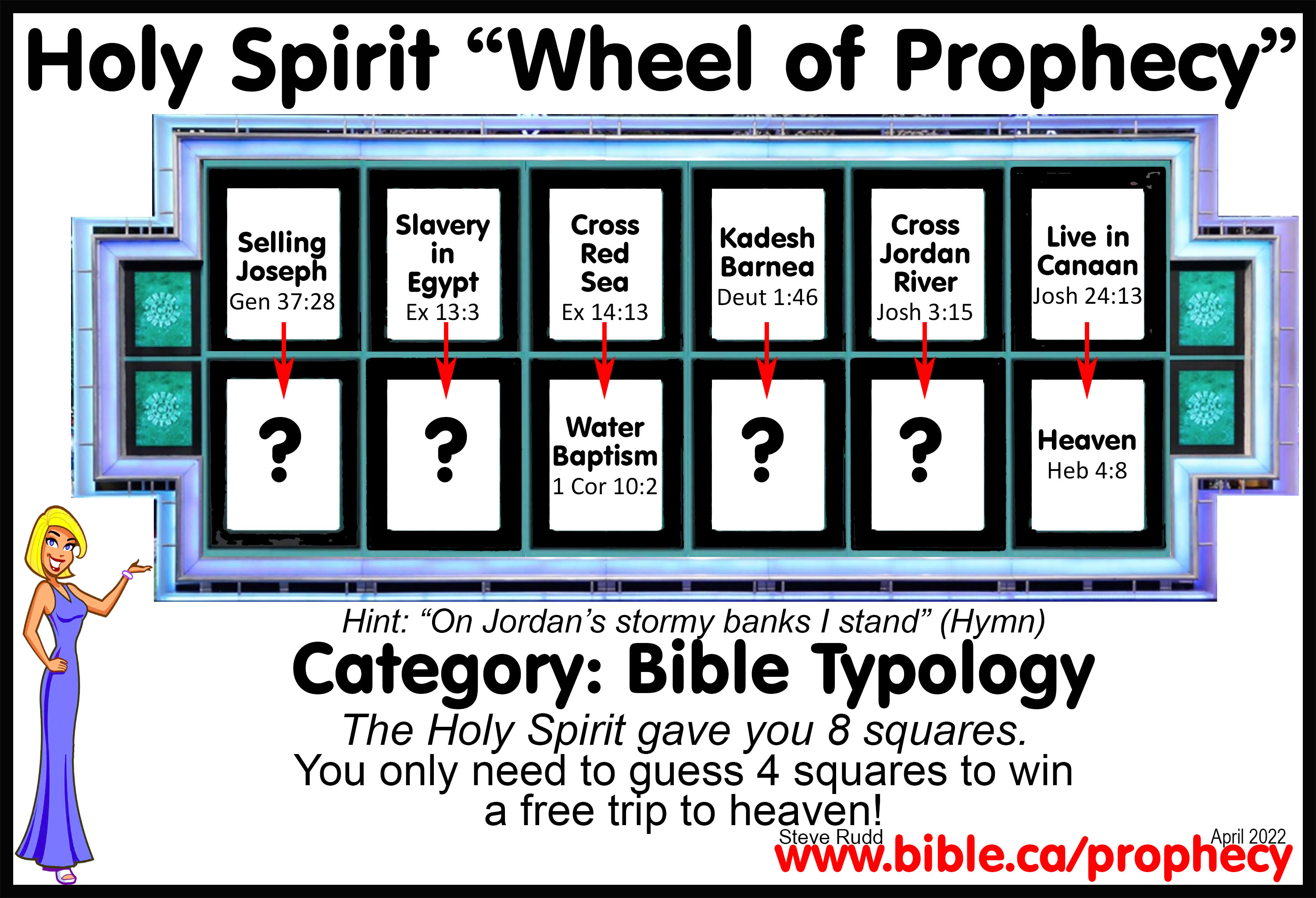
b.
Play the Holy Spirit Typology Game Episode #1: Your category is Bible Typology of the
Tabernacle. There is a total of 13 types. The Holy Spirit has given you 21
squares as clues. You must complete the full typology by guessing the 5
remaining squares to win a free trip to heaven!
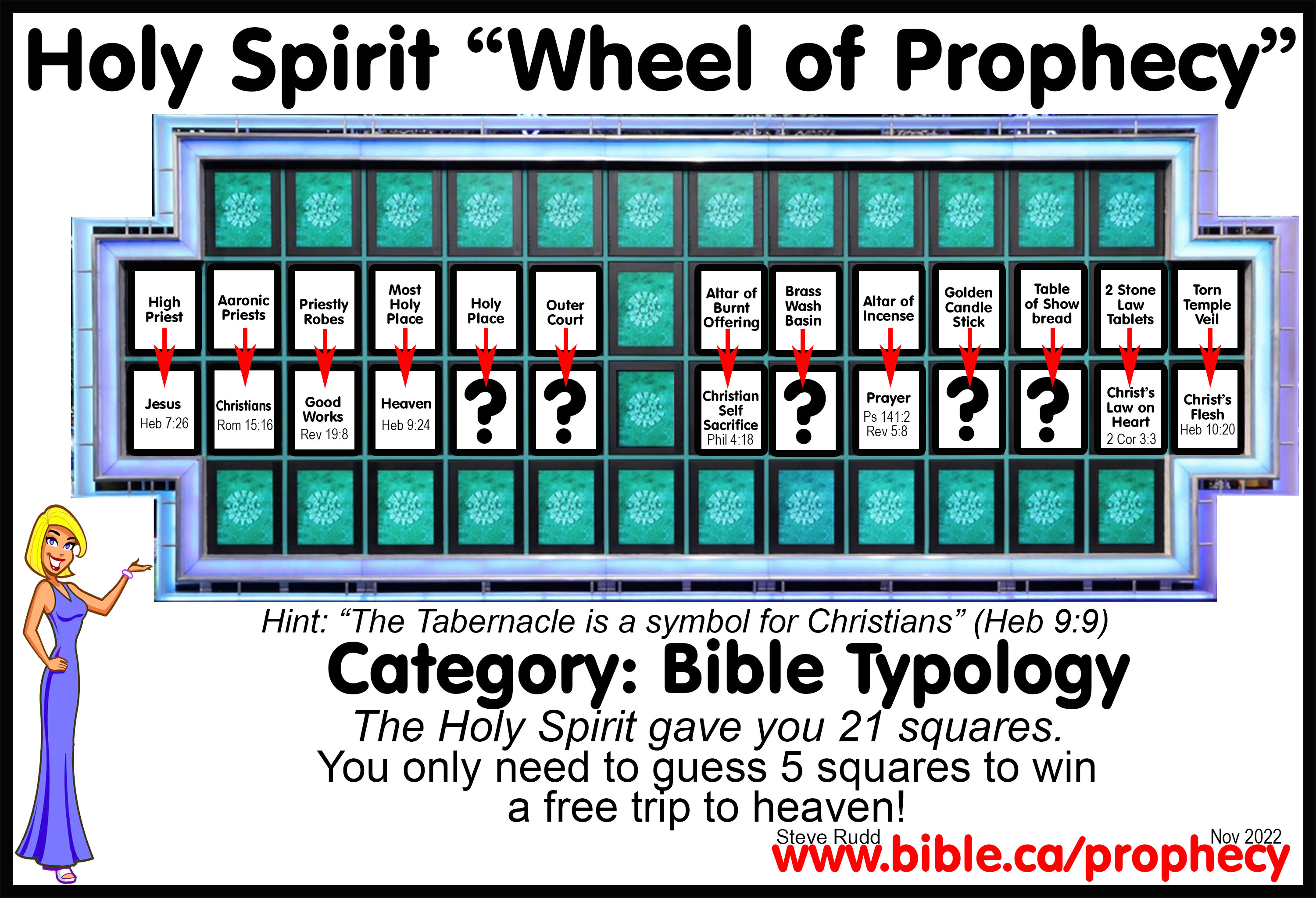
c. Discussion: There were three articles in the holy place but we are only told that the incense (inferring the alter of burnt incense) represents our prayers. The original symbol is that the incense originates in the holy place room and drifts across the veil into the most holy place room where God dwells. This the Holy Spirit has directly identified that incense is a type of prayer, but says nothing about the Altar of Incense. But the typology behind the two other articles the furniture in the holy place, namely the golden candlestick and the table of show bread are not specifically identified by the Holy Spirit. The candlestick the is widely seen a type of the light of word of God or Christians themselves. The table of Showbread is widely seen as a type of the Lord’s Supper. The Holy Spirit identified typology that existed between the copy and true tabernacles, and specifically identified a few for us to get us started, then leaves it up to us to decode the rest of the meanings behind the earthly tabernacle. Are we certain about these interpretations? No. But apparently the Holy Spirit was confident we would figure it out for ourselves once he took off our training wheels and gave us a push into the world of types and antitypes. There is no logical reason to assume that the Holy Spirit identified every Old Testament echo, shadow, and type in the New Testament and there is strong evidence they do exist.
8. Typology was widely taught in the first century church, non-Christian Jews and early church fathers. Regardless of whether you accept or reject the typologies Jews and Christians suggest, the practice of associative typology between the Old and New Testament was universal in the Christian church for the first 500 years.
a. AD 30: The writings of Jewish Philo are notoriously filled with endless typologies and metaphoric connections. While Philo is a good example of finding allegorical typologies in almost everything, most of which was likely misguided, his approach was widely used in the first century. In fact, one of the reasons Philo was preserved for us today, is because his work was widely accepted among Jews and early Christians.
b. AD 70: As a Jew, Josephus used typology as proof of God’s judgement on the destruction of Jerusalem on 6th August AD 70 because the temple was burned in 587 BC and AD 70 on the same day of the year (10th Av). “God had for certain long ago doomed it to the fire; and now that fatal day was come, according to the revolution of ages; it was the tenth day of the month Lous [Ab], upon which it was formerly burnt by the king of Babylon … for the same month and day were now observed, as I said before, wherein the holy house was burnt formerly by the Babylonians. (269)” (Josephus Wars 6.249-250, 269)
c. AD 200-600: Early Christians created metaphoric meanings for Elim and Marah: (from ACC, Vol 3, p 83-84) “The wood that restores the sweetness to water is Christ” (Tertullian). “The waters of baptism are of no avail unless the cross of Christ is preached” (Ambrose). “The seventy palm trees remind us of Christ’s seventy disciples” (Jerome). “The bitter water was the law of the Old Testament, which needed to be tempered by the cross of Christ … “Marah and Elim stand in sharp contrast. Marah had one bitter spring; Elim had twelve sweet ones. This is a contrast between the law and the gospel … They arrived at a place called Elim, where there were twelve very pure springs of water and a multitude of seventy flourishing palm trees. See the mystery of God—how, after the bitterness of the law, the richness of gospel piety abounds. There the one spring is harsh to drink, but here the many are all sweet to imbibe. Once there was no refreshment after weariness, but now there is refreshment after labor. For springs are at the disposal of the thirsty, and palms are offered to victors. Palms are offered to victors, I say, because after the hardness of the law it is a victory to have arrived at the grace of the gospel. For part of the victor’s reward is to moisten his mouth from a flowing spring and to take the triumphal palm in his hand. With the spring the confessor’s tongue is purified, and with the palm the martyr’s hand is honored—the former because it has praised the glory of Christ, the latter because it has refused the altar of sacrilege. (Maximus of Turin, Sermon 68.2.) The Meaning of Elim. Bede: When the people of God went out from Egypt, their sixth resting place, in which “there were twelve fountains of water and seventy palm trees,” was called Elim (that is, “of rams”), so that both by its name and by its appearance it might contain the figure of the apostles and the apostolic men. On the Tabernacle 2.4.
d. AD 325: Eusebius goes into great detail how he view Moses as a type of Constantine the Great (Eusebius Life of Constantine 1.12). Considering the central role Constantine played ending 3 centuries of Roman persecution of Christians and his baptism into Christ for the remission of sins in a full immersion baptistry in AD 323 he had built in Rome in AD 318, it is not surprising that early Christians inferred Constantine’s entire life was the result of the direct providence of God. This may or not be a God arranged typology, but it is certainly a possibility to consider since God called pagan Nebuchadnezzar and Cyrus the Great, “My servant”, “My anointed”, “My shepherd” (Jeremiah 25:9; 27:6; 43:10; Isaiah 45:1; 44:28).
e. AD 400: Augustine describes in Confessions 11-12 a literal, factual approach to the Genesis creation account where God created everything out of nothing “ex nihilo (Augustine, Confessions 12.7). Then in confessions 13, he looks back and finds allegorical and typological connections. Literal heaven and earth are types of “spiritual vs. carnal” humans (13:13) echoing Paul’s words in 1 Cor 2:14 and Rom 12:2. The stars created on day four were a type of scripture which divided day/truth from night/error and provides illumination for truth (13:18). The creation of fish and birds on day 5 and “living souls” on day 5 are a type of water baptism and the Lord’s Supper (13:20-21). While these are all bizarre and extreme examples of typology and most certainly wrong, Augustine was one of the most prominent and highly respected church fathers of the fifth century AD. It is important to note, however, that Augustine did not change his literal view of the creation account, with typology. Nor did he fabricate any new doctrines for the church. What he did was to find allegorical types between the literal Genesis creation account and established church doctrine of his day.
9. Most preachers and brethren recognize there are valid types that are not specifically identified as such by the Holy Spirit in the New Testament. This is especially true, since many of the types, like the 75 similarities between Joseph and Christ, are so obvious, you would have to be blind to miss them. The 75 parallels of Joseph as a type of Christ force any reasonable person to conclude that this was by design and could only have occurred by God’s providential arm that directed the events and details. Otherwise, it becomes a specular coincidence with odds equal to winning the lottery 75 times in a row. While we cannot be sure that all of the Joseph/Christ types that are proposed are valid, many of them clearly are.
a. “There is probably no one in the entire Old Testament who is more closely a type of the Lord Jesus Christ than is Joseph; however, he is never spoken of as a type in Scripture. The analogy between the two is striking.” (Thru the Bible with J. Vernon McGee, Vol 5, p592, 1997 AD)
b. “We will finally compare the past rejection of God's servants with the Jews' rejection of Jesus. The case of Joseph provides a striking parallel. (1) God chose Joseph as the one who would deliver his family; God chose Jesus as the one to deliver his people. (2) Joseph's brothers hated him and got rid of him (temporarily); Jesus' fellow Jews hated him and crucified him. (3) Joseph was exalted; Jesus was exalted in heaven. (4) Joseph became the savior of his brothers; Jesus became the savior of those who had hated him.” (Truth Commentary on Acts, Johnny Stringer, Edited by Mike Willis, Acts 7:15; p136, 1999 AD)
c. “Christ was also preached in prophecy. The gospel of Christ was preached in type throughout the Old Testament. Joseph, Moses, the high priests, the tabernacle, and the temple were all types of Christ and the church. The tabernacle was a beautiful type of the church. It was a two room structure surrounded by an enclosed court or yard. The first room of the tabernacle was just twice the size of the second. The first room or holy place, was a type to the church. It had three articles of furniture: the table of showbread on which were twelve loaves which were renewed each Sabbath by the priests. This typified the Lord’s Supper. The golden candlestick with seven branches, which was kept burning continually, was a type of the Bible, our only source of light in the church. The altar of incense, on which incense was offered twice daily, was a type of prayer.” (The Greatest Institution, Loren N. Raines, Truth Magazine, Edited by Mike Willis, pp. 48-49, January 1983 AD)
d. “The Greek form of the name in this text, Iesus, Jesus is the same as the name “Joshua.” It is found in this form also in Acts 7:45. “Joshua” as it appears in English, is the transliteration of the Hebrew jehoshua, “the Lord is salvation.” The naming of Joshua in this manner designates him as a kind of type of Jesus.” (Truth Commentary on Hebrews, Daniel H. King, Sr., Edited by Mike Willis, Heb 4:8, p133, 2008 AD)
e. “Nothing but faith, persevering faith, can enable the Christian to pass safely through all the trials and dangers of the wilderness, uphold him amid the waves of the Red Sea of affliction and the swellings of the Jordan of death, and give him a sure and everlasting resting-place in the Canaan above. (Truth Commentary on Hebrews, Daniel King, Edited by Mike Willis, Heb 11:29, 2008 AD)
f. “Abel’s blood cried out from the earth for justice and judgment upon the one who had murdered him. The blood that he offered “from the firstlings of his flock and of the fat thereof” (Gen. 4:4) was a mere shadow or type of the sacrifice of our Lord. The blood of Jesus Christ, on the other hand, speaks of atonement, reconciliation, justification, sanctification, pardon, and salvation. This represents clearly the contrast between the two dispensations. (Truth Commentary on Hebrews, Daniel H. King, Sr., Edited by Mike Willis, Heb 12:24, p438, 2008 AD)
g. “In one sense, that judgment is presaged in the death of Jesus at the hands of the leaders of the nation to be destroyed. In another sense, God was picturing judgment of sin in allowing His Son to die because of man’s iniquity and to save mankind from the guilt of his own evil. And in another sense, the darkness foreshadowed the final judgment when those who refuse the Son will stand before God to give account of the deeds done in the body. The darkness symbolized the very purposes of the cross in God’s eternal plan for human redemption.” (Truth Commentary on Luke, Colly G. Caldwell, Edited by Mike Willis, Luke 23:45, p438, 2011 AD)
10. While not all similar events or objects are typical, collections of similar patterns indicate clear typology. Only when looking back with enlightened New Testament understanding, do we see how many Old Testament characters and events are types of New Testament characters and events. Seeing a single elephant in the clouds means nothing but seeing 10 lined up trunk-holding-tail, is clearly by intentional design. While there are many “one up” types, many are “patterns of types” between bible characters. The probability that these “pattern of types” is the results of the deliberate providence of God is high. A few examples of “pattern types” between Old and New Testament characters include:
a. A list of 15 similarities of Abraham as a type of Christians
b. A list of 75 similarities of Joseph as a type of Christ
c. A list of 64 similarities of Moses as a type of Christ
d. A list of 26 similarities of Moses as a type of Apostle Paul
e. A list of 13 similarities the Jewish temple was a type of the Church
f. A list of 13 Exodus Route types of our salvation in Christ
g. A list of 14 similarities of Joshua as a type of Christ
h. A list of 40 similarities of Elijah and Elijah as a type of John the Baptist and Christ
III. Master Classification Catalogue of Midrashic Bible Prophecies:
1. Citing direct, literal fulfillment in Old Testament texts widely understood before the time of Christ to be messianic prophecies without any other possible fulfillment:
a. The book of Daniel: Daniel 2:44 and Isaiah 2:2-5 were clearly predictive of the arrival of the Messiah once Rome (4th kingdom) conquered the Greek kingdom. Daniel 9:24-27 was clearly predictive that the messiah would arrive in AD 33 which was 490 years (70 weeks) after the decree to rebuild Jerusalem (Ezra 7). These two-time prophecies, along with many other messianic prophecies sparked great expectation at the time of John the Baptist, who baptized Jesus during the 70th week of Dan 9: Luke 3:15.
b. The branch-king-child to be born (Isa 4:2; 7:14; Isaiah 9:6-7; 11:1-2; 53:2) and key sections of the suffering servant in Isa 53 are all exclusive to the messiah. The messianic branch-king in Jer 23:5; Zech 3:8 is expanded to the messianic branch-king-priest in Zechariah 6:12-13.
2. Dual prophecies and secondary fulfilments of prophetic events being applied to Jesus:
a. 2 Sam 7:14 was not initially viewed as messianic until Zechariah 6:12-13 stated that the messianic branch-king-priest would also build a temple of God after the death of Solomon. Acts 2:29-31 and Heb 1:5 directly applies this to Jesus. However no New Testament passage directly names Jesus as the builder of a temple (His body/church) by quoting 2 Sam 7.
b. Isaiah 7:14 was fulfilled in 733 BC when Isaiah’s son was born in Isaiah 8, but Matthew finds new secondary fulfillment in the Mary’s virgin birth after the fact in Mt 1:23. Isaiah 7:14 was a dual prophecy first fulfilled in Isaiah himself in 733 BC, then Mary in 2 BC.
c. Dan 8 & 11 specifically prophesied the 167 BC Abomination of Desolation by Antiochus IV, but Jesus reapplies this prophecy in a new way to AD 70 in Mt 24:15.
d. Haggai 2:2-23 finds full fulfillment in Zerubbabel in 515 BC but then Paul in Hebrews finds two new and distinct fulfillments first on Pentecost then the second coming.
e. Isaiah 53 was fulfilled first by Isaiah himself when he was sawed in half by king Manasseh while hiding in a tree in 685 BC and then by Christ when he was crucified on a tree in AD 33.
f. Psalm 2 is spoken in the first person by David who was God’s son, God’s king and God’s anointed. Yet we find in Acts 13:32–33 that this is fulfilled when Christ was begotten at the resurrection of Christ. It was after the resurrection that “all authority on heaven and earth” (Mt 28:18; Eph 1:20-23)
3. Messianic application of historic events in Bible characters that were not viewed as messianic at the time when it originally happened. Through God’s power, providence and foreknowledge these historical events were deliberately and specifically intended by God to be later echoed by both Jesus and Christians in the messianic age.
a. The exodus narration was not messianic yet, just as God called Israel out of Egypt, so too God called Jesus out of Egypt: Mt 2:15.
b. Jesus words on the cross, “My God why have you forsaken me” (Psalm 22:1) were mouthed by David at a time he thought he was about to be captured and killed by King Saul when he was surrounded in 1 Sam 23:26. David escaped death at the hands of Saul but Jesus was crucified.
c. In Psalm 68:18, God ascends to the summit of Mt. Sinai to take his seat on the throne in 1446 BC during the Exodus. Paul in Eph 4:8 applies this to the ascension of Christ in AD 33 when He received the kingdom days before Pentecost. Just as God supernaturally endowed the workmen to build the tabernacle, so too Jesus endowed the early church with 9 supernatural gifts. Yet the Midrashic application of Sinai is expanded to include the death, burial, resurrection in Eph 4:9-10 where Paul explains his choice of quoting Ps 68:18. If Paul had never made the application this way, nobody would have ever guessed that God on Mt. Sinai was a type of the death, burial, resurrection and ascension of Christ to sit and rule far above all rule and authority in heaven!
4. New allegorical interpretations and typology based upon known Old Testament stories:
a. The Sarah, Hagar story is applied to Christians and Jews in Gal 4.
b. Peter’s application to water saving Noah from the sins of the world become the allegorical foundation of the water baptism saving the lost from their own sins: 1 Pe 3:20-21. Up to this point the ark was viewed as the saving vehicle of Noah form the water that killed the sinners. Through inspiration Peter presents something new and surprising by focusing, not on how Noah was saved by the ark from the water, but rather how the water saved Noah by washing away the sins of the entire world. While water baptism by full immersion for the remission of sins had been taught since Pentecost AD 33 (Act 2:38) and Paul had his sins “washed away” through water baptism in AD 36 (Acts 22:16), Peter’s associating the flood waters of Noah to Christian baptism was revolutionary and new theology. In fact all 5 metaphors for water baptism are typical Midrashic interpretation style: Water baptism is a washing (Acts 2:38; 22:16) , a new birth (Jn 3:3-5), a clothing (Gal 3:27), a circumcision (Col 2:12) and an imitation of the death burial and resurrection of Christ (Rom 6:3-7)
c. The crossing of the Red Sea at the Straits of Tiran in 1446 BC was not a messianic event, yet Paul in 1 Corinthians 10:1-4 connected the full immersion crossing during the Exodus to water baptism. It was already understood that we are baptized into Christ but Paul reaches back to the Red Sea crossing as a type where Israel was baptized into Moses. This is a brand new concept and meaning of Israel’s relationship with Moses. "For I do not want you to be unaware, brethren, that our fathers were all under the cloud and all passed through the sea; and all were baptized into Moses in the cloud and in the sea; and all ate the same spiritual food; and all drank the same spiritual drink, for they were drinking from a spiritual rock which followed them; and the rock was Christ." (1 Corinthians 10:1–4)
d. The husband and wife relationship is allegorically applied to Christ and the church in Eph 5:22-33.
5. Connecting Jesus to Old Testament prophecies through “word plays”.
a. two “word plays” in Mt 2:23: The first word play is based upon how the Greek word for Nazareth sounded like the Hebrew word for Branch so that He shall be called a Nazarene = Jesus the branch of David grew up in “branchland” (Nazareth). The second play is based upon how Nazareth and Nazarite are similar sounding words in Greek and that the LXX substitutes "Holy one of God" in place of “Nazarite” both in Judg 13:7 and 16:7. Jesus was universally known as the "Holy one of God". The messiah was to be holy one of God. Samson the Nazarite was also the holy one of God.
6. Reenactment rituals of Old Testament events in the church.
a. The Lords Supper is a reenactment ritual of the death of Christ founded on the Passover (Ex 12) and Manna (Ex 16/Jn 6).
b. Water baptism is a reenactment ritual of the death, burial and resurrection of Christ (Rom 6:3-4).
7. New Testament ritual with multiple Old Testament types:
a. Lord’s Supper: Manna, Passover and the Table of Shewbread are three types of the Lord’s Supper in the church.
b. Baptism: Noah’s flood, Circumcision, Red Sea crossing, the Tabernacle bronze laver, the healing of Naaman of Leprosy by immersing seven times in the Jordan, wearing white clothes after immersion in Synagogue Mikveot, are five types of Christians full immersion water baptism for the remission of sins. There are 5 metaphors of baptism: ritual purity washing, circumcision, clothing, new birth, reenactment of death, burial and resurrection.
8. Cherry picking phrases from a multiple of Old Testament texts to form a single New Testament quotation:
a. Romans 9:23-31 = Hos 2:23 + Hos 1:10 + Isa 10:22-23 + Isa 1:9
b. Romans 10:18-21 = Ps 19:1 + Deut 32:21 + Isa 65:1-2
c. Romans 15:8-12 = 2 Sam 22:50 + Deut 32:43 + Ps 117:1 + Isa 11:10
d. 2 Corinthians 6:16-18 = Ex 29:45 + Midrashic paraphrase Is 52:11 + Midrashic paraphrase 2 Sam 7:14
e.
Eph 6:14-17 = Isa 11:5 + Isa 59:17 + Isa 52:7 + Isa
49:2 Paul cherry picks a series of disconnected phrases from Isaiah and sews
them together into a single unit interspersed with Roman soldier imagery. The
flaming arrows of the Satan is a reference to the “Roman Scorpion Engine” was a
catapult which launched flaming spears and arrows.
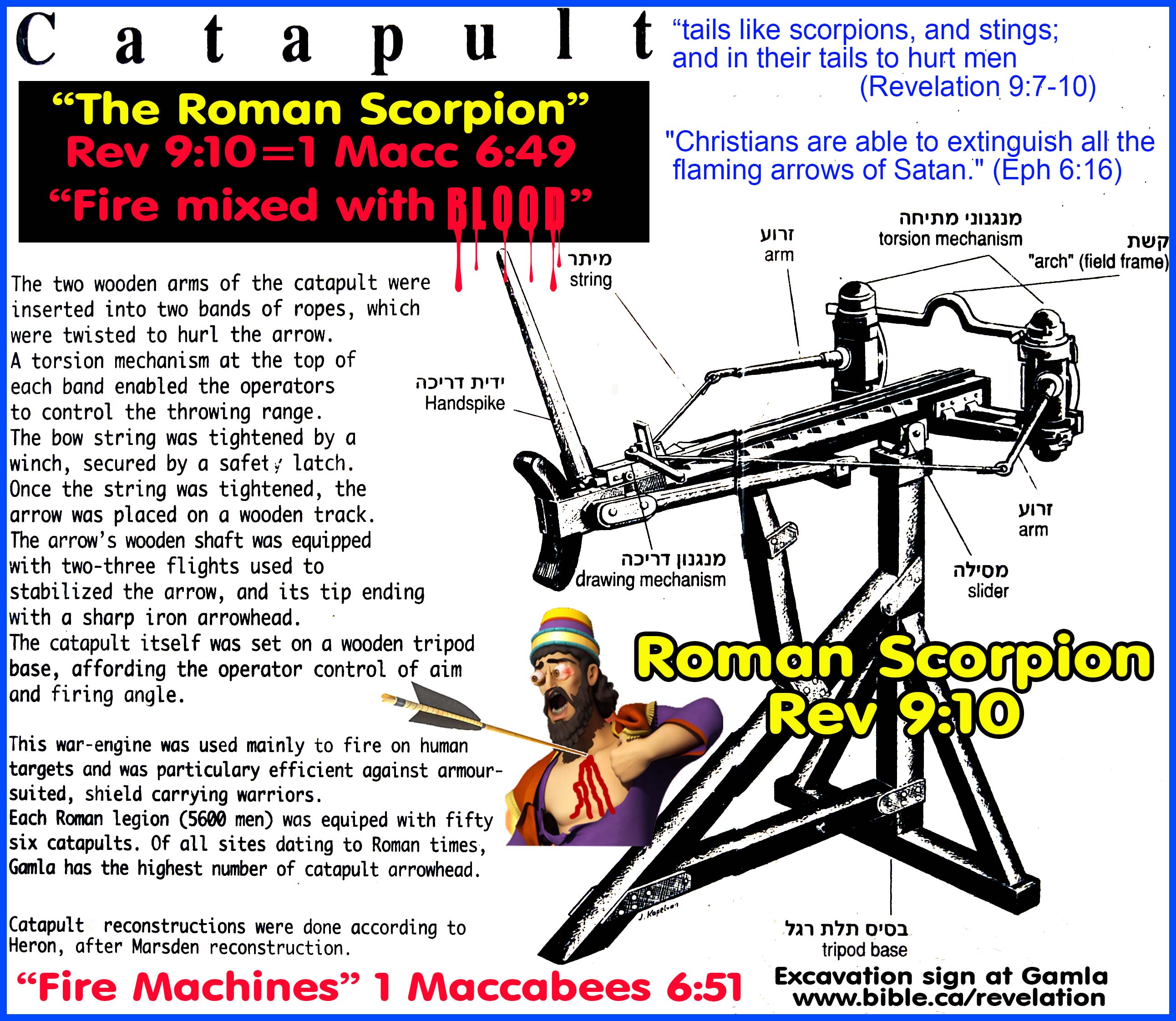
9. Paraphrases that add and subtract information from the original source and are applied to Jesus:
a. Ephesians 5:4 paraphrases Isaiah 60:1-2 and applies language previously assigned to YHWH in a new way to Jesus. In the original God is shining but in Ephesians Christ is shining.
10. Midrashic allusions and inferences:
a. In the great incarnation of Christ passage of Phil 2:6-10, Paul applies language in Is 45:23 where every knee will bow and every tongue will confess to YHWH, to Jesus.
b. Paul twice applies the Mosaic law of not muzzling the ox while it is threshing in Deut 25:4 to Christian preachers drawing wages for their work in 1 Corinthians 9:7-14 and 1 Tim 5:18. This concept is never applied to anyone under the mosaic age and represents an entirely new and surprising prophetic text.
c. The key phrase “let all the angels of God worship Him” is quoted almost exactly in four ancient sources: Dead Sea scroll 4Q44, Septuagint, Odes 2:43 Apocrypha LXX and Justin Martyr.
d.
Hebrews 1:5 quotes Deut 32:43 (LXX)
and Psalm 97:7 (LXX) as a messianic prophecy that the Angels are to worship
Christ during his earthly ministry. Dead Sea Scroll 4Q44 validates the
Septuagint reading that Angels are to worship Jesus in Heb 1:8. What we learn
from 4Q44 is that Heb 1:8 was primarily quoting Deut 32:43 LXX not Ps 97:7. In
both Deut 32:43 (LXX) and Psalm 97:7 passage to indicate the object of worship
is YHWH which is specifically applied to Jesus. In other words without Heb 1:6
we would have no idea this was a messianic prophecy of Jesus. Even more
striking is that these are the last words of the Song of Moses immediately
before his death. Deut 32:43 therefore serves as a bridge between Moses and
Christ based upon Deut 18:18 where Moses understood he would be replaced by
Christ. Most important, we clearly understand that Jesus is Yahweh (YHWH) GOD
to be worshiped. When we couple this with Hebrews 1:10-12, we learn Jesus is
also the creator YHWH/GOD. This verse not only proves Jesus is God it also
proves Jesus is not an angel.
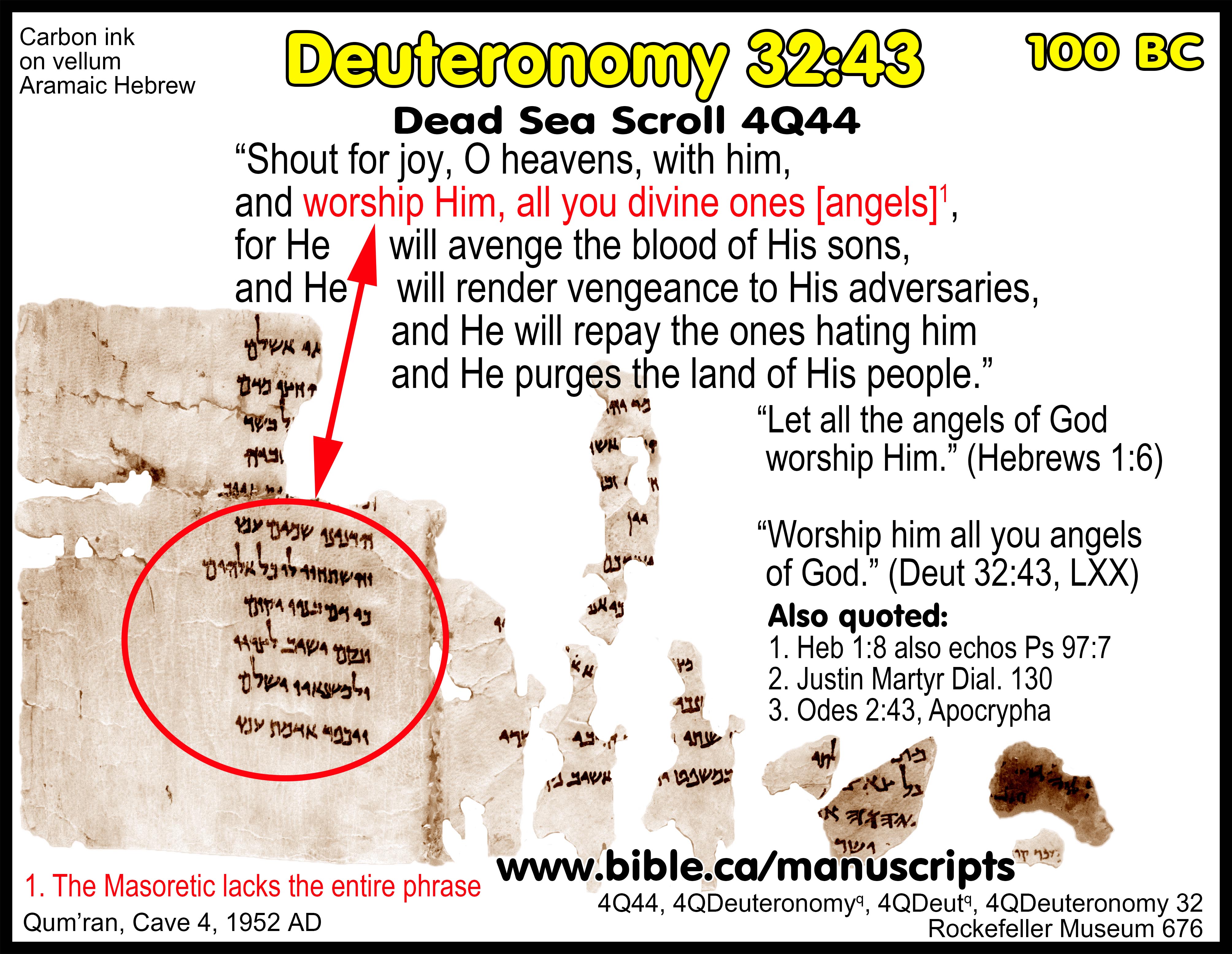
e. Hebrews 1:8-9 quotes Psalm 45:6-7: "But of the Son He says, “Your throne, O God, is forever and ever … Therefore God, Your God, has anointed You." Ps 45:6 the Father is called God, but in Heb 1:8 Jesus is called God by the Father. This standard Midrashic hermeneutic would be a surprising new development to the historic Jewish interpretation of the passage. While Jews might object that Jesus is God or the Messiah they would not object to the way Paul connected the two verses because it was the same method they had used countless times.
f. Hebrews 1:10-12 quotes Psalm 102:25-27 as a messianic proof text that Jesus is the creator God in Genesis 1:1. This would come as a shocking surprise to Torah compliant Jews who had converted to Christianity. There is nothing in Ps 102 that indicates it is messianic and it had been universally been applied to the Father by the Jews until the arrival of Christianity.
g. Psalm 8:6 echoes Gen 1:26 that God put all earth animals in submission under mankind’s feet. Suddenly and without any warning Ps 8:6 is directly applied to Jesus in Heb 2:9 and 1 Cor 15:27. Looking back we now understand Gen 1:26 as a messianic prophecy of the time when Christ would have all authority on heaven and earth between the resurrection and the second coming as Mt 28:18 confirms.
Conclusion:
1. Without faith, it is impossible to please God and Bible scoffers who are unmoved by prophecy would likely be among 9 of the 10 lepers who were healed by Jesus but never offered thanks, among Judas who witnessed the miracles of Jesus but betrayed him, among the guards who were thrown to the ground by Jesus but went on to arrest him for crucifixion, among the Jewish Sanhedrin who knew Jesus had performed valid miracles but then stoned Stephen to death, among the Synagogue leaders to whom Paul powerfully refuted in public, demonstrating by the Scriptures that Jesus was the Christ.
a. A small handful of Messianic prophecies irrefutably and unassailable prove Jesus is the Messiah and the Bible was written and inspired by the divine Holy Spirit.
b. Bible prophecy silences unbelievers who attack scripture and will haunt their consciences all the way to their judgement.
2. It may be surprising for Christians to learn that the majority of Old Testament texts that were quoted in the New Testament as fulfilled messianic prophecy, were only understood as such after they were fulfilled. This does not belittle or invalidate the power of these messianic prophecies because they demonstrate God’s power and foreknowledge when we look back and see God shaping history according to His master plan. The human heart is awe-struck not only when God tells us in advance his eternal purpose and it is so, but also when we learn about His completed plan in the past.
a. When Christians use Bible prophecy for apologetic purposes to convince hostile unbelievers that the Bible is inspired, it is important to carefully chose only a select few the strongest examples.
b. This study highlights how Christians sometimes have a distorted view of Bible prophecy texts and their fulfillment.
c. Christians will compose a valid list 60 Old Testament prophecies and their corresponding fulfillment in the New Testament without looking at the original context of the Old Testament prophecy.
d. It is important for Christians to differentiate between prophecies that were understood to be predictive of future events before their fulfillment looking forward vs. prophecies that were understood to be predictive only after they were fulfilled when looking back.
3. The Midrashic Hermeneutic was the system of Bible interpretation that the Holy Spirit employed in writing the Bible through inspired men to find fulfillment in Jesus. There are nine different categories of how prophecy was considered fulfilled by New Testament writers:
a. Citing direct, literal fulfillment in Old Testament texts widely understood before the time of Christ to be messianic prophecies without any other possible fulfillment.
b. Multiple fulfillment prophecies where the first fulfillment is in a Bible character hundreds of years before Jesus and a secondary messianic fulfilment in Jesus. Many of the specific elements fulfilled in the original prophecy are either changed or ignored in the Messianic fulfillment.
c. Messianic application of historic events in Bible characters that were not viewed as messianic at the time when it originally happened. Through God’s power, providence and foreknowledge these historical events were deliberately and specifically intended by God to be later echoed by both Jesus and Christians in the messianic age.
d. New allegorical interpretations and typology based upon known Old Testament stories.
e. Connecting Jesus of Nazareth to Old Testament prophecies through “word plays”.
f. Old Testament historical events that became messianic reenactment rituals in the church.
g. Cherry picking out of context phrases from a multiple of Old Testament texts to form a single New Testament quotation.
h. Paraphrases of Old Testament texts that add and subtract information from the original source.
i. Midrashic style allusions and inferences in the Old Testament applied to Jesus of Nazareth.
Be like the Ethiopian Eunuch who became a Christian by reading Isaiah 53:
"Then the Spirit said to Philip, “Go up and join this chariot.” Philip ran up and heard him reading Isaiah the prophet, and said, “Do you understand what you are reading?” And he said, “Well, how could I, unless someone guides me?” And he invited Philip to come up and sit with him. Now the passage of Scripture which he was reading was this: “He was led as a sheep to slaughter; And as a lamb before its shearer is silent, So He does not open His mouth. “In humiliation His judgment was taken away; Who will relate His generation? For His life is removed from the earth.” The eunuch answered Philip and said, “Please tell me, of whom does the prophet say this? Of himself or of someone else?” Then Philip opened his mouth, and beginning from this Scripture he preached Jesus to him. As they went along the road they came to some water; and the eunuch said, “Look! Water! What prevents me from being baptized?” And Philip said, “If you believe with all your heart, you may.” And he answered and said, “I believe that Jesus Christ is the Son of God.” And he ordered the chariot to stop; and they both went down into the water, Philip as well as the eunuch, and he baptized him. When they came up out of the water, the Spirit of the Lord snatched Philip away; and the eunuch no longer saw him, but went on his way rejoicing." (Acts 8:29–39)
Be like the Berean Synagogue Jews who became Christians by studying how Jesus fulfilled prophecy:
"Now these were more noble-minded than those in Thessalonica, for they received the word with great eagerness, examining the Scriptures daily to see whether these things were so. Therefore many of them believed, along with a number of prominent Greek women and men." (Acts 17:11–12)
By Steve Rudd 2020: Contact the author for comments, input or corrections.
